If you think I've been laying low photography-wise during the winter, you couldn't be more wrong. The months of December-February and into March have been very productive. In fact, I have taken some of the best images of my life during my numerous camera outings in recent weeks and months.
Of course, I always say that I just took the best images of my life, and I always mean it. Will the general public agree? Probably not. To the untrained and uncaring eye, my images will be the same old, same old landscapes, now with the added deterrent of desaturated colors, boring, gray skies, and downright dreariness.
But that's the point. In a country where colorful sunsets are almost as rare as mountain ranges, if a landscape photographer can't deal with the grayness of fall and snow-less winter (which lasts from June through April), he might as well sell his equipment. You'd better learn to turn gray and bare into art or you will find yourself stuck at home.
So that's exactly what I have been working on. I have seen the overcast skies and naked trees as a challenge. If I can make those look good, I can do anything. And by "good" I don't necessarily mean beautiful or appealing. The goal is to prompt an emotion other than just "blah... this is boring". Sometimes the best way to achieve that is by presenting the pure, unadulterated grayness, other times by drawing out whatever little bit of color is sometimes there if you look hard enough: those little patches of orange leaves hanging onto their branch for dear life, the green moss on a tree trunk, or an aqua colored tint in a layer of ice.
Most of the pictures in this series were taken in well-known local territory, within walking distance from my home. You would think I'd get tired of that, but it continues to amaze me how different the landscape can look in different seasons - heck, even from one day to the next. With spring and summer showing the forest in its finest green robes and extravagant prom gowns, the winter time is a piercing x-ray of what's underneath the lavishness - and sometimes that ain't pretty, but it's always fascinating.
Bruce Springsteen once said that as a young, unknown rock band you need to both think you are the greatest thing in music since the Beatles... and that you suck. The former gives you the confidence and attitude to maybe make others believe it too, and the latter makes you work harder at actually getting better.
This is not unlike how I feel as a photographer. In my own mind I am among the world's most underrated photo artists, but most external evidence tells me that I'm just another mediocre face in the ever growing mass of mediocre middle aged men with expensive cameras resting on their pot bellies.
When I look at my pictures from maybe just a year ago, I can see that the evidence was accurate: most of the pictures I thought back then were masterpieces, I now realize were nothing special and that the world's indifference to them was quite reasonable. On the other hand, the pictures I took today are mind blowing and will finally give me the recognition I deserve.
But then fear strikes me. What if in a year from now I can see that the pictures I now think are mind blowing are just as unremarkable as my old pictures? What if my pictures are not improving at all? What if the only thing that's improving is my state of denial?
As an amateur photographer, you don't have very many solid indicators to tell you if you're getting better. You can't measure it by sales since you're not selling. Friends and family may just tell you what you want to hear. And your own gut feeling and tastes prove worthless as images you wouldn't be caught dead having taken receive more votes/likes/awards than yours on GuruShots/Instagram/ViewBug.
Whatever the case, as of right now, in the confines of my own deluded, self-absorbed brain, I believe that the last couple of months have produced some of my best images ever. I have not written about it due to being busy tired, but November and December have been very productive in both quantity and quality with several photo outings, each of which brought forth sure additions to my portfolio should I one day get around to updating it.
Since I may still write more extensively about those outings, I will only post a few of the best shots here. The first two images are from the same day in November, a day that was split in two with the first half spent at the beautiful Bøllemose area with a low sun creating magical light between the trees, and the second half on the coast, including a blue hour to die for at a nearby marina. 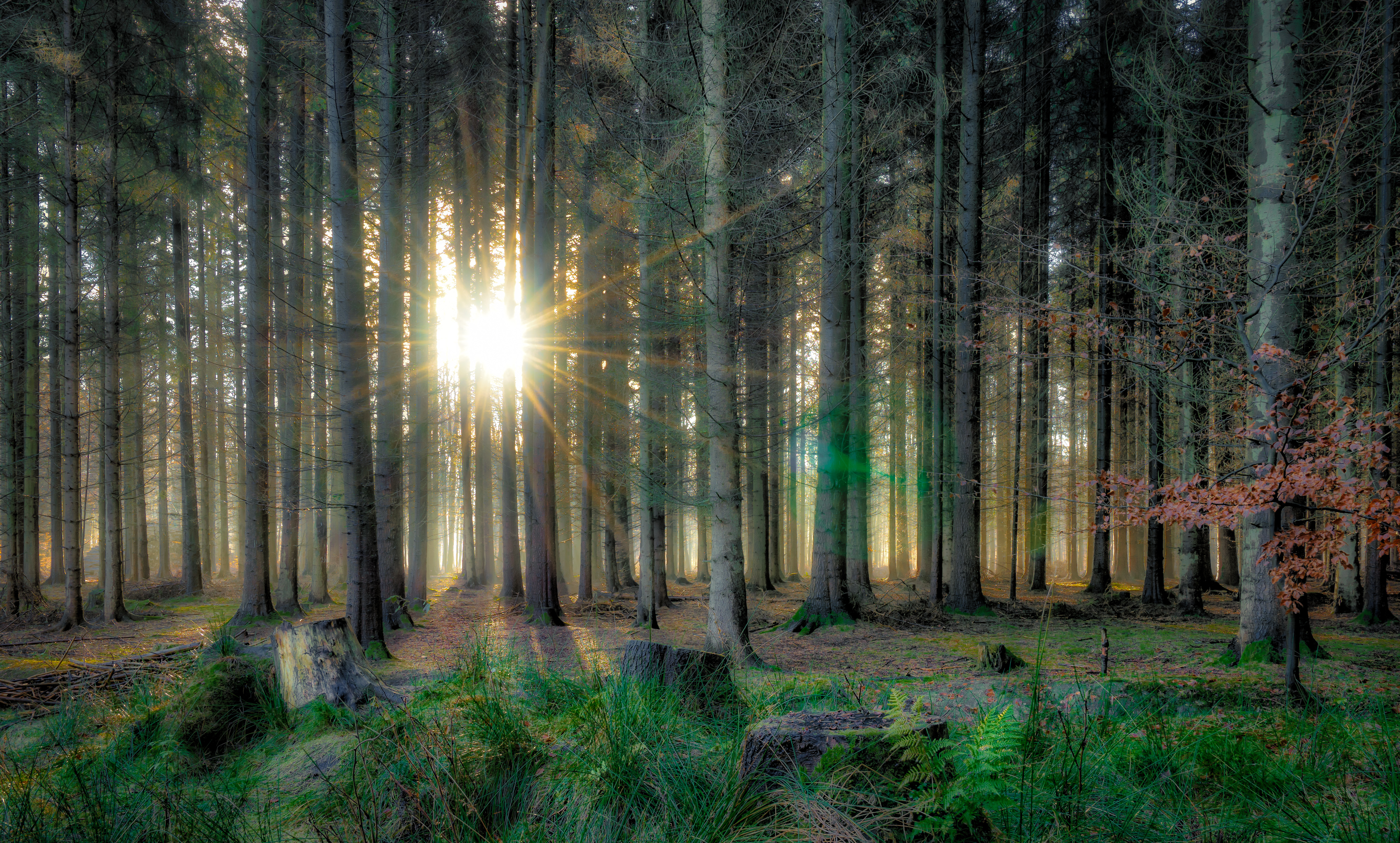
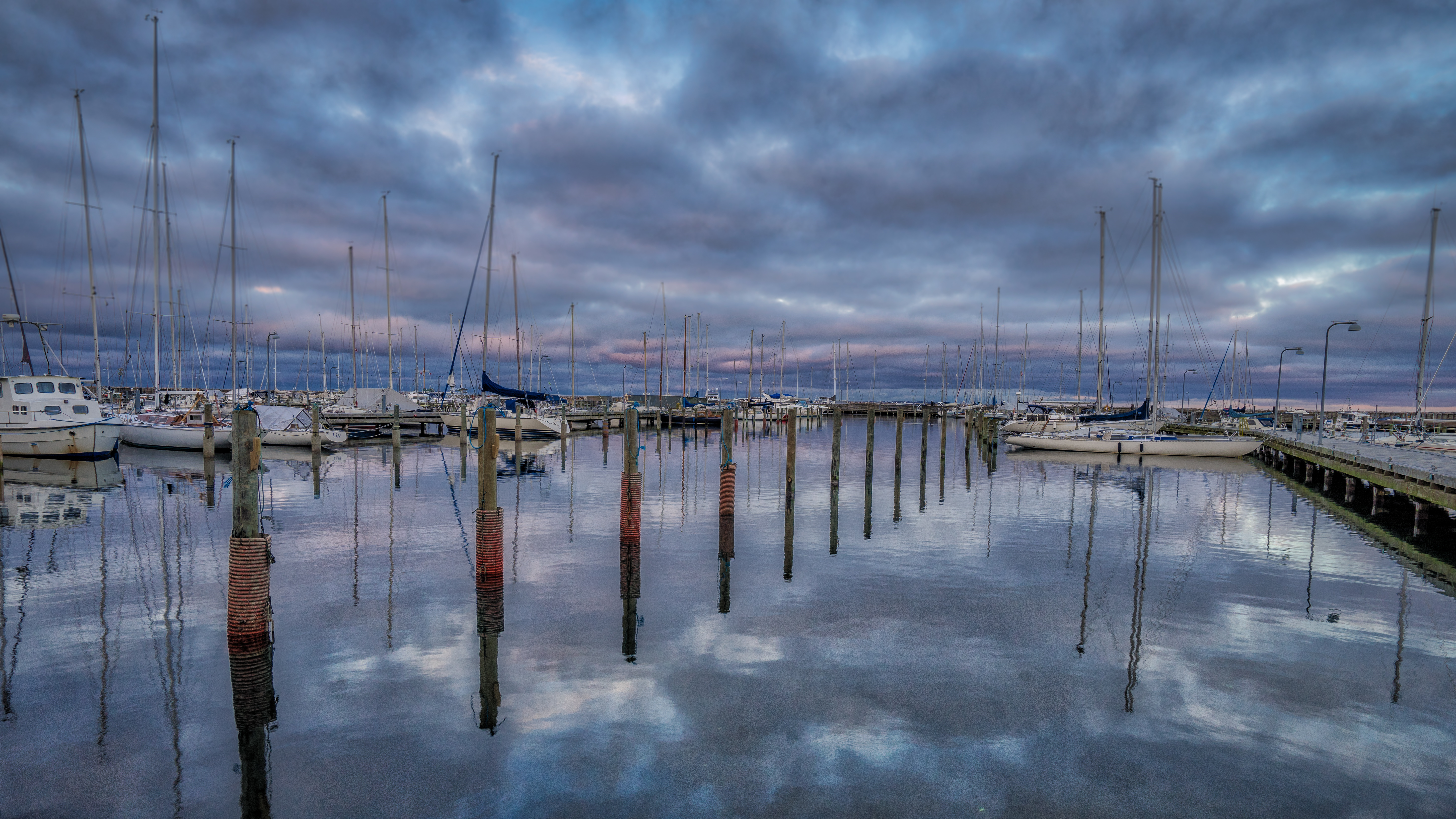 The next image is from my local area where, one Sunday afternoon, I spent the hours around the early Scandinavian sunset on a rugged, muddy field, almost ruining my boots, but capturing some pictures that I was really happy with., including this one.
The next image is from my local area where, one Sunday afternoon, I spent the hours around the early Scandinavian sunset on a rugged, muddy field, almost ruining my boots, but capturing some pictures that I was really happy with., including this one.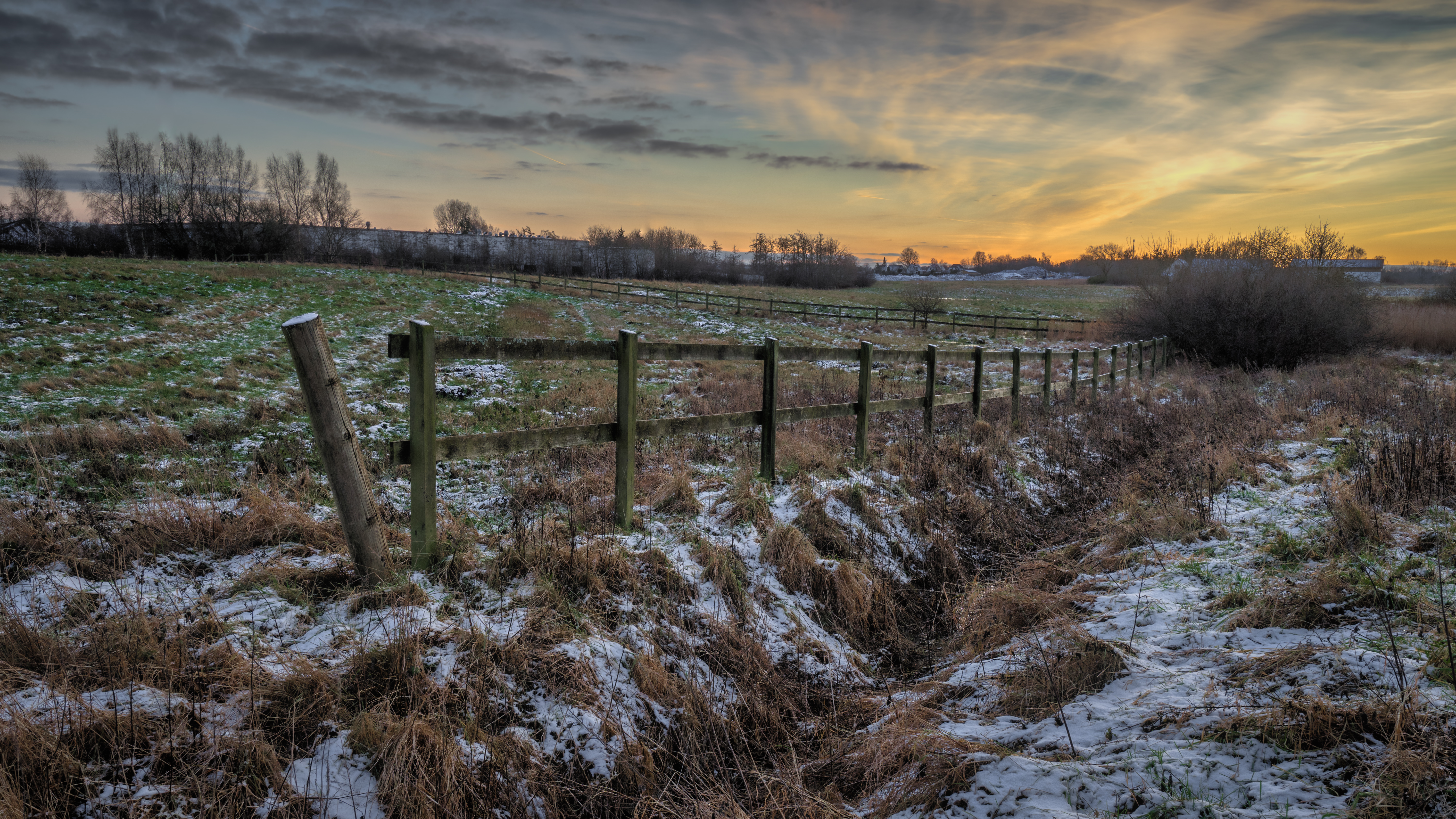 Also from my local area is the below picture of the weirdly curved tree on the edge of the forest. I absolutely love the colors and composition in this one.
Also from my local area is the below picture of the weirdly curved tree on the edge of the forest. I absolutely love the colors and composition in this one. 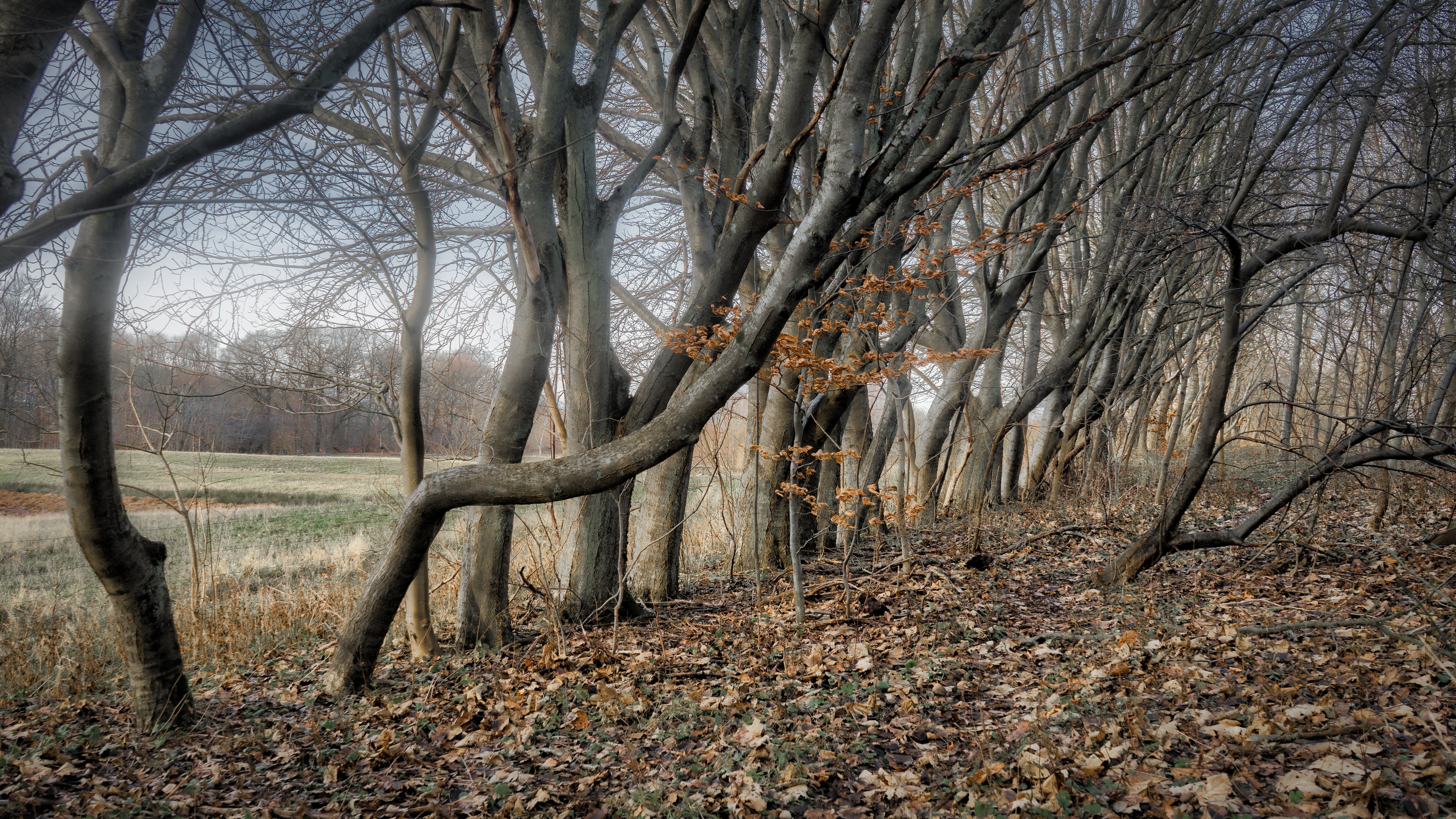 Last but not least, from a trip into Copenhagen and beyond, this image was taken at a part of the city called Ørestad, which has only existed in the past 10 years or so. The picture of a train leaving the station was very nicely captured, in my own opinion, with the exposure length at a perfect 0.6 seconds, which added juuust the right amount of blur... again, in my own opinion.
Last but not least, from a trip into Copenhagen and beyond, this image was taken at a part of the city called Ørestad, which has only existed in the past 10 years or so. The picture of a train leaving the station was very nicely captured, in my own opinion, with the exposure length at a perfect 0.6 seconds, which added juuust the right amount of blur... again, in my own opinion.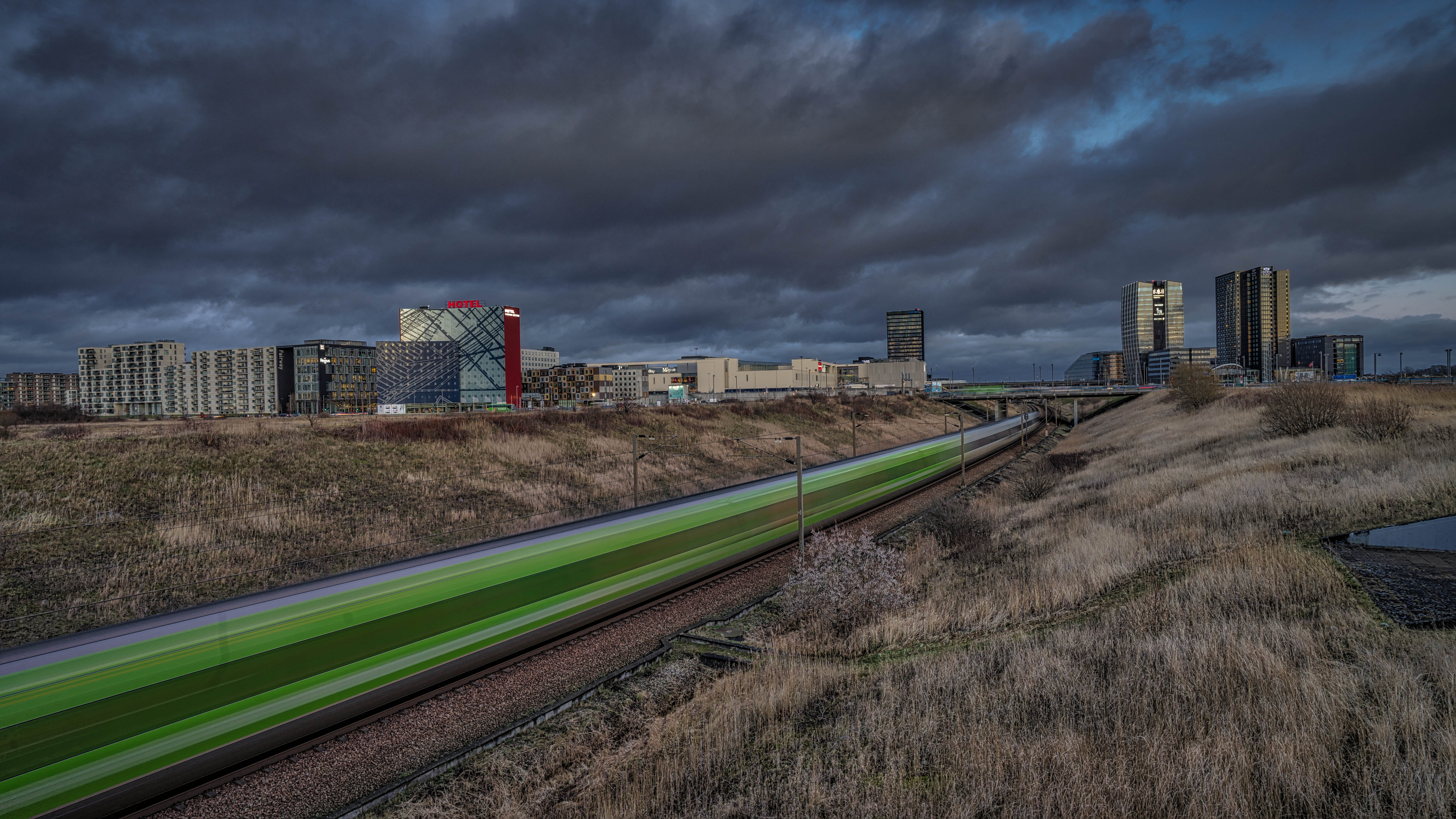 I took several more top-notch pictures on all of those trips, but they will have to wait. These are just examples of what I've been up to in the last few months and hopefully a little bit of evidence that both my mastering of my camera and my ability to capture the beauty I encounter have indeed improved.
I took several more top-notch pictures on all of those trips, but they will have to wait. These are just examples of what I've been up to in the last few months and hopefully a little bit of evidence that both my mastering of my camera and my ability to capture the beauty I encounter have indeed improved.
I guess we'll see in a year from now.
Back in July I wrote about the time of year when the beautiful, bright leaves of the beech trees light up the forest and make your shutter finger itch. If there is a time of the year that is as important for photographers here in Denmark as those weeks in May, it would be October and November when those same trees explode in orange and yellow colors.
Fortunately, I recently had the opportunity to visit the ultimate location in the area for fall photography, the stunning nature resort Dyrehaven just 30 minutes from downtown Copenhagen. Dyrehaven is a combination of forest and open plain. It is not a huge area. You can walk through it in an hour or so (unless you stop every two minutes to take pictures, in which case it takes three), but due to some kind of government or city decree, no one is allowed to build houses that stick up above the tree line when you stand on the big hill in the center. In other words, it feels like an isolated natural reserve, and it's easy to forget how close you are to the city.
The only problem on this day was the light. The sky was gray and dreary, but the clouds were still well-defined and therefore things could have been much worse. I certainly preferred this to a clear blue sky.
First we have the entrance gate to the area. It is in itself a beautiful structure, and with the fall leaves framing it, it just lends itself to photography. 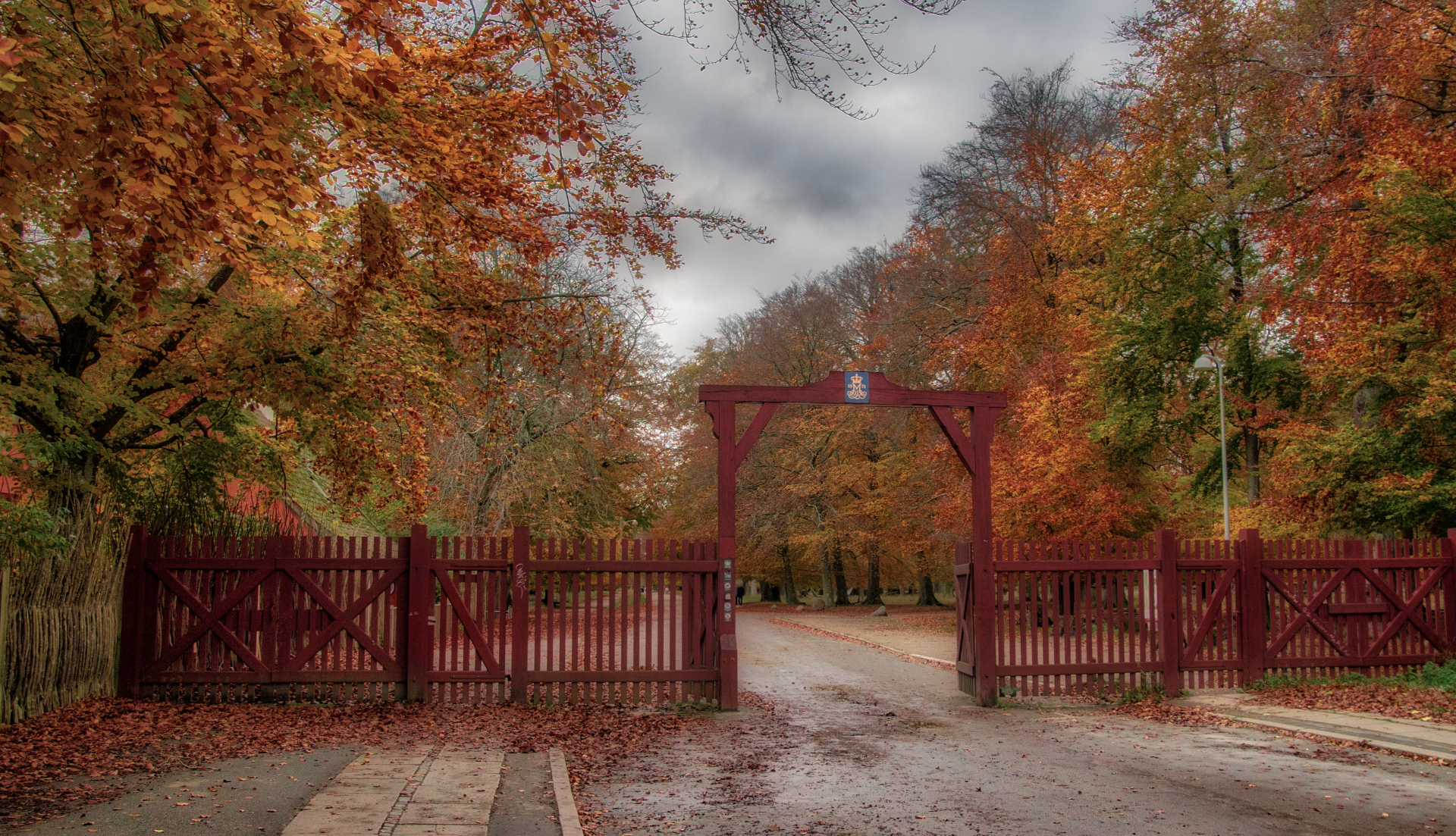 The next image is the only one in the bunch taken with my cell phone. I always snap a few images with my cell phone when I'm on a photo shoot. just to have some for my Instagram and just because cell phone images have a different flavor that sometimes make a nice addition to my collection, as was the case with this one. None of my shots taken with my real camera captured the way the leaves formed a low ceiling over the leaf-covered forest floor quite as well.
The next image is the only one in the bunch taken with my cell phone. I always snap a few images with my cell phone when I'm on a photo shoot. just to have some for my Instagram and just because cell phone images have a different flavor that sometimes make a nice addition to my collection, as was the case with this one. None of my shots taken with my real camera captured the way the leaves formed a low ceiling over the leaf-covered forest floor quite as well.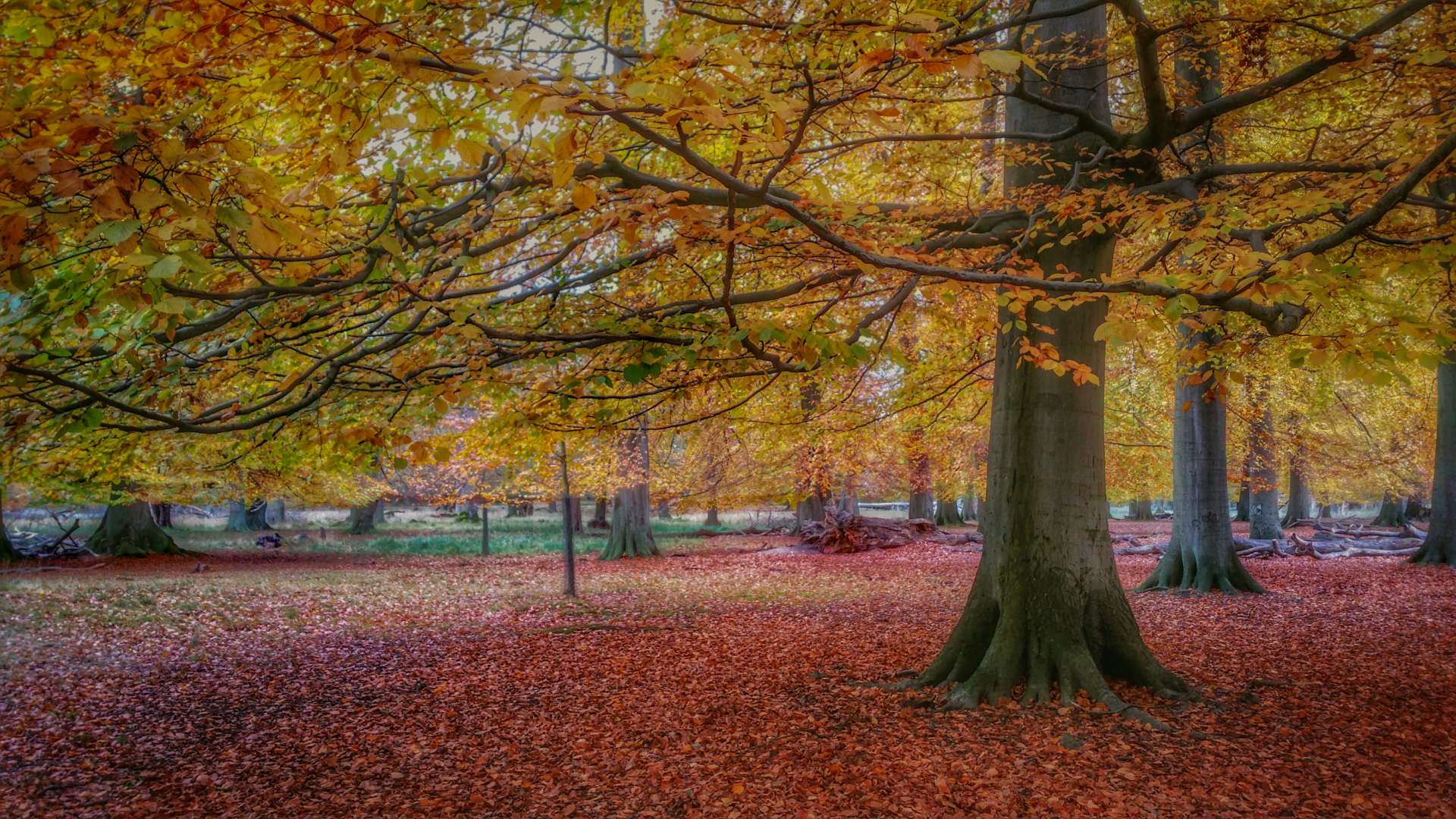 Moving on, the forest was replaced by more open landscape interspersed with awesome old orange-leafed trees that begged to be photographed. I especially liked this old oak tree - or whatever it is. And no, this would not have worked with a clear blue sky as the background. Old, crooked trees require gloomy, gray clouds.
Moving on, the forest was replaced by more open landscape interspersed with awesome old orange-leafed trees that begged to be photographed. I especially liked this old oak tree - or whatever it is. And no, this would not have worked with a clear blue sky as the background. Old, crooked trees require gloomy, gray clouds.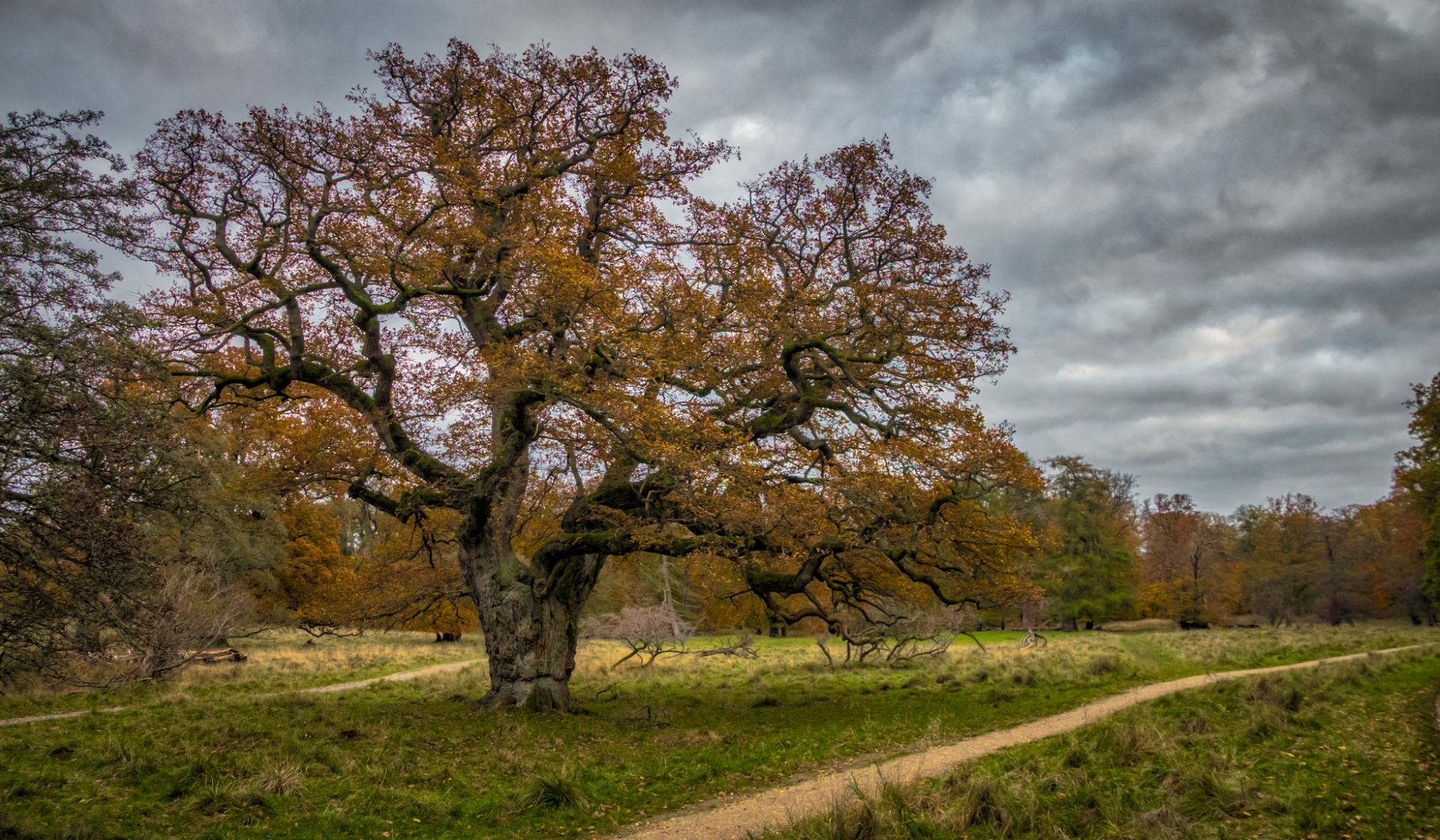 As I continued up the hill in the center of Dyrehaven, I came across the pond shown below with a swan couple floating around. At this point the sun was setting and the sky had started to break up a little bit, showing some blue and purple colors. I spent quite some time there, shooting the pond from all kinds of angles. And waiting for the swans to not be grooming their feathers and not sticking their heads into the water looking for food. They do that a lot, and it's not how you want to see swans in photos. You want them with those beautiful, curved necks held high or, as in this case, with their wings spread in an angel pose.
As I continued up the hill in the center of Dyrehaven, I came across the pond shown below with a swan couple floating around. At this point the sun was setting and the sky had started to break up a little bit, showing some blue and purple colors. I spent quite some time there, shooting the pond from all kinds of angles. And waiting for the swans to not be grooming their feathers and not sticking their heads into the water looking for food. They do that a lot, and it's not how you want to see swans in photos. You want them with those beautiful, curved necks held high or, as in this case, with their wings spread in an angel pose.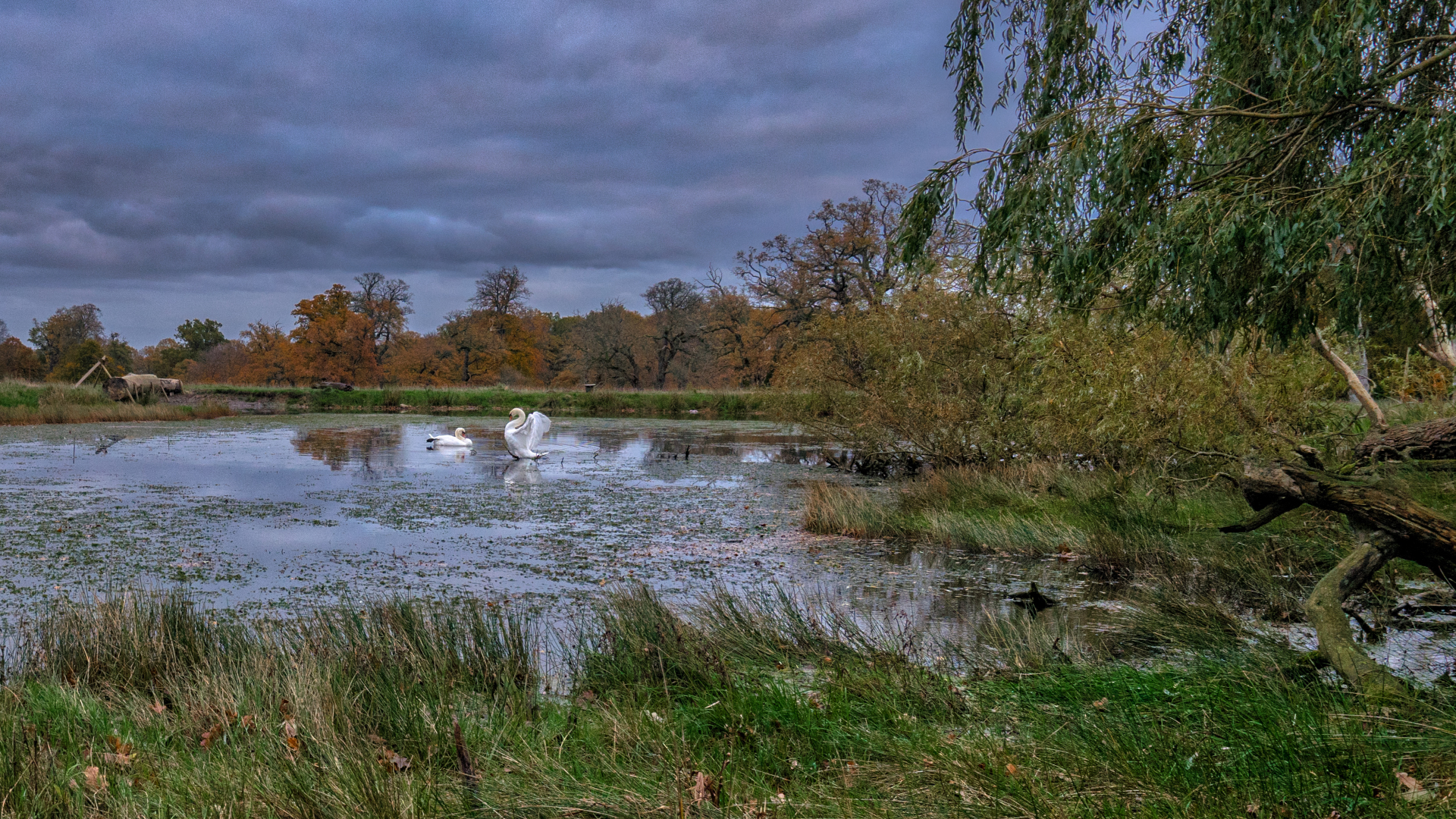 At the very top of the hill, there is a tiny castle called the Hermitage Hunting Lodge or, in Danish, Eremitageslottet. Dyrehaven is also referred to as the Hermitage and used to be a royal hunting ground. Every year a horse race with riders in traditional red hunting coats takes place. They don't hunt anything other than a victory in the race, although more modern hunting (thankfully without horses or dog packs) does happen in order to control the number of game.
At the very top of the hill, there is a tiny castle called the Hermitage Hunting Lodge or, in Danish, Eremitageslottet. Dyrehaven is also referred to as the Hermitage and used to be a royal hunting ground. Every year a horse race with riders in traditional red hunting coats takes place. They don't hunt anything other than a victory in the race, although more modern hunting (thankfully without horses or dog packs) does happen in order to control the number of game.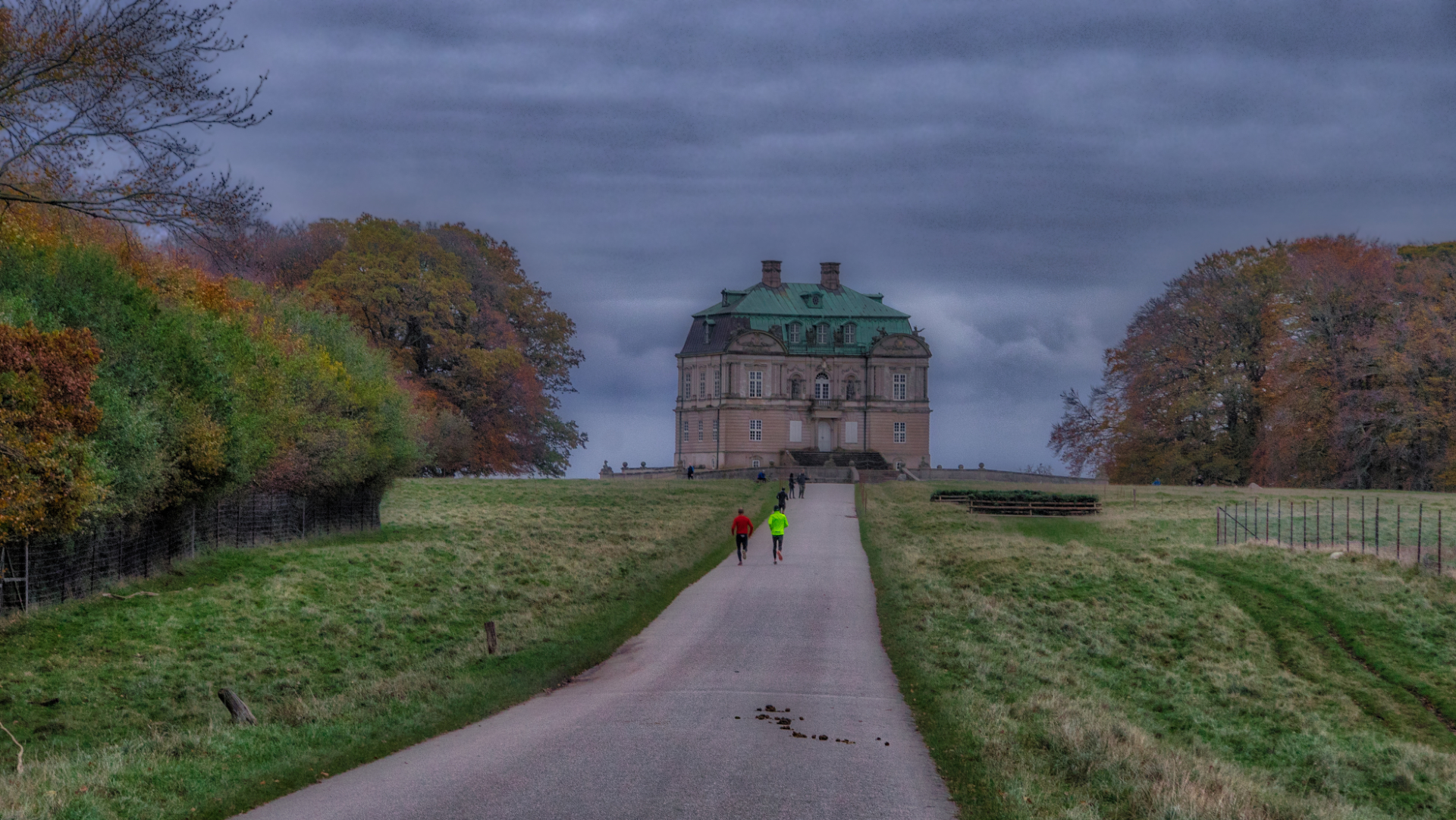 That brings me to one of the absolute coolest features of Dyrehaven: deer. The place is full of them, in all shapes and sizes. You cannot avoid seeing them if you tried. I had taken a few pictures of a herd of deer earlier in the day, but it wasn't until I was headed for the park exit that I got close enough for something like the image shown below. Unfortunately, it was getting dark at this point, forcing me to use an extremely high ISO of 6000+ in order to get any sharpness at all. Still, several images, including this one, turned out quite well, which speaks for my Sony camera's noise-reduction capabilities... as well as Lightroom's.
That brings me to one of the absolute coolest features of Dyrehaven: deer. The place is full of them, in all shapes and sizes. You cannot avoid seeing them if you tried. I had taken a few pictures of a herd of deer earlier in the day, but it wasn't until I was headed for the park exit that I got close enough for something like the image shown below. Unfortunately, it was getting dark at this point, forcing me to use an extremely high ISO of 6000+ in order to get any sharpness at all. Still, several images, including this one, turned out quite well, which speaks for my Sony camera's noise-reduction capabilities... as well as Lightroom's.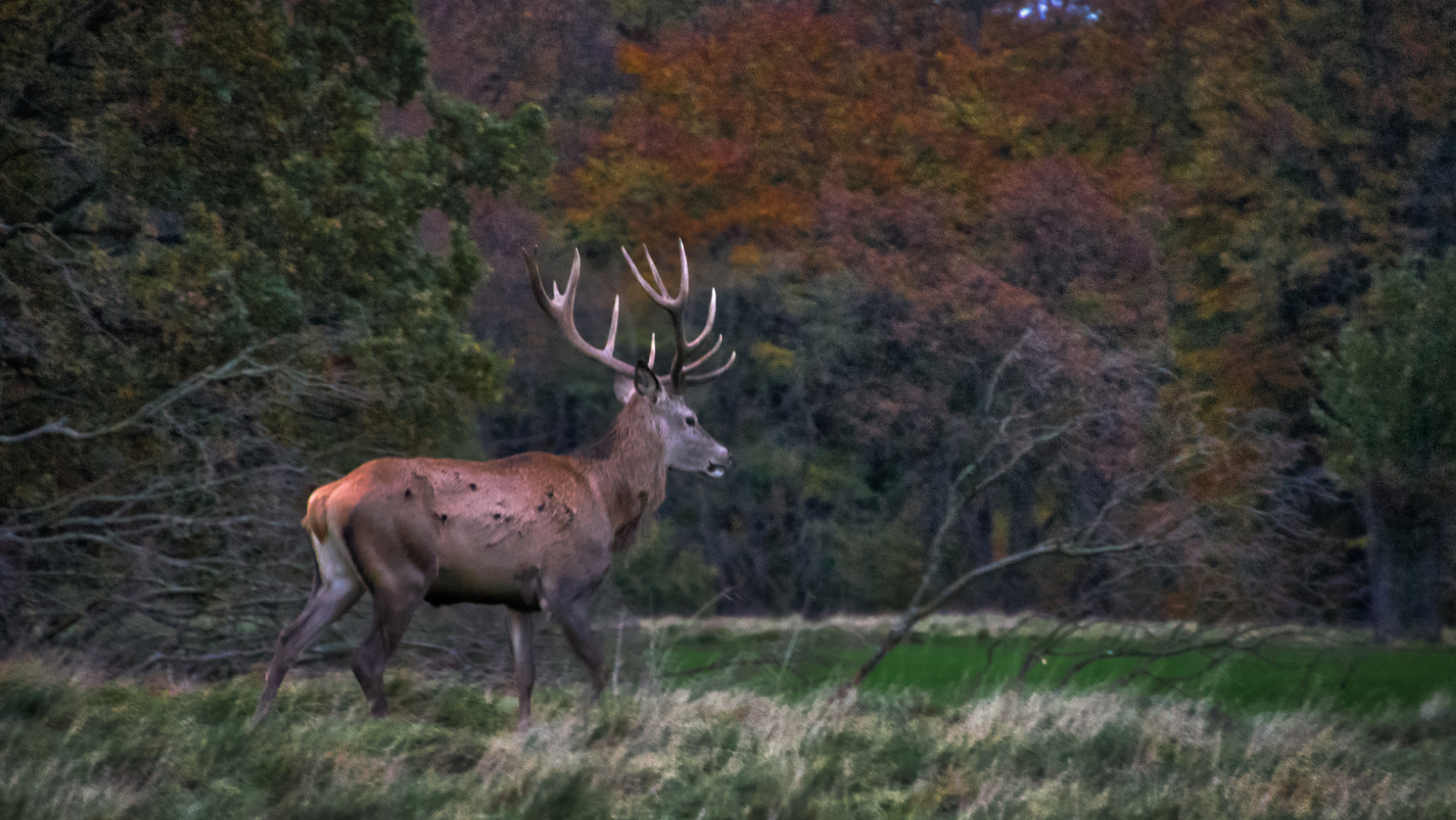 Darkness had now fallen and it was time to head out. I'd enjoyed several hours of the most exquisite nature and landscape you will find that close to a big city. Given that it was a week day and late in the year, I felt like it had been just me and the deer there. I relished in the peace and quiet and closeness to nature, which really is what it's all about.
Darkness had now fallen and it was time to head out. I'd enjoyed several hours of the most exquisite nature and landscape you will find that close to a big city. Given that it was a week day and late in the year, I felt like it had been just me and the deer there. I relished in the peace and quiet and closeness to nature, which really is what it's all about.
On the way back to the train station, 30 drunken teenagers boarded the bus and tore me out of my zen. Although I was never a drunken teenager myself, I can't say at that age I had a whole lot more appreciation for the original, natural world than these partying youngsters seemed to have. I don't know exactly when it changed for me, but I'm glad it did and that I have photography to help me suck it in and bring it home for further absorption.
It started back in August at a birthday party for my brother and niece. Out of nowhere my brother hands me a piece of paper stating that he and his girlfriend won't be buying me any birthday or Christmas presents for the next several years. I'm like, "What's happening? It has to be some kind of joke, except, I don't get it."
Then, after a few minutes, he hands me a package, and again, I'm confused. My birthday was months ago. We are not here to celebrate me. Why are you giving me a present? Well, I proceed to open the package, and what is that? Out of the wrapping paper appears a box containing a Sony FE 16-35 mm Vario-Tessar lens with Zeiss optics. At this point, I'm utterly confused. First he doesn't want to buy me any presents, and then he hands me this... It takes several minutes for me to put two and two together. The lens I'm now holding in my hand is my birthday/Christmas present for the next several years. My brother and I usually don't buy each other huge gifts. This is exceptional. This is unheard of. This is awesome!
Once my brain manages to bring the emotional roller coaster ride to a halt, I start to realize what this means. The lens that is now in my possession is one that would have taken me years to save up for, and that's provided I could muster the self-discipline required to save up at all, which is not my strongest suit.
It also means I will no longer have a technical excuse for not taking pictures that can compare with the best. I have the camera, I have the lens. It is now up to me to learn how to utilize this combination and to raise my artistic level to match the technology.
Well, two months later I'm starting to see the results. I have not made a shot by shot comparison to see the difference between my old Tamron wide-angle lens and the new one, but in my mind there's no doubt that the new lens provides visibly better results in terms of sharpness. Look at this image I took in Copenhagen a few weeks back. I just haven't seen that kind of sharpness in my pictures in objects that far away before. Sure, it was a clear, sunny day, but I'm pretty sure that's not the whole explanation.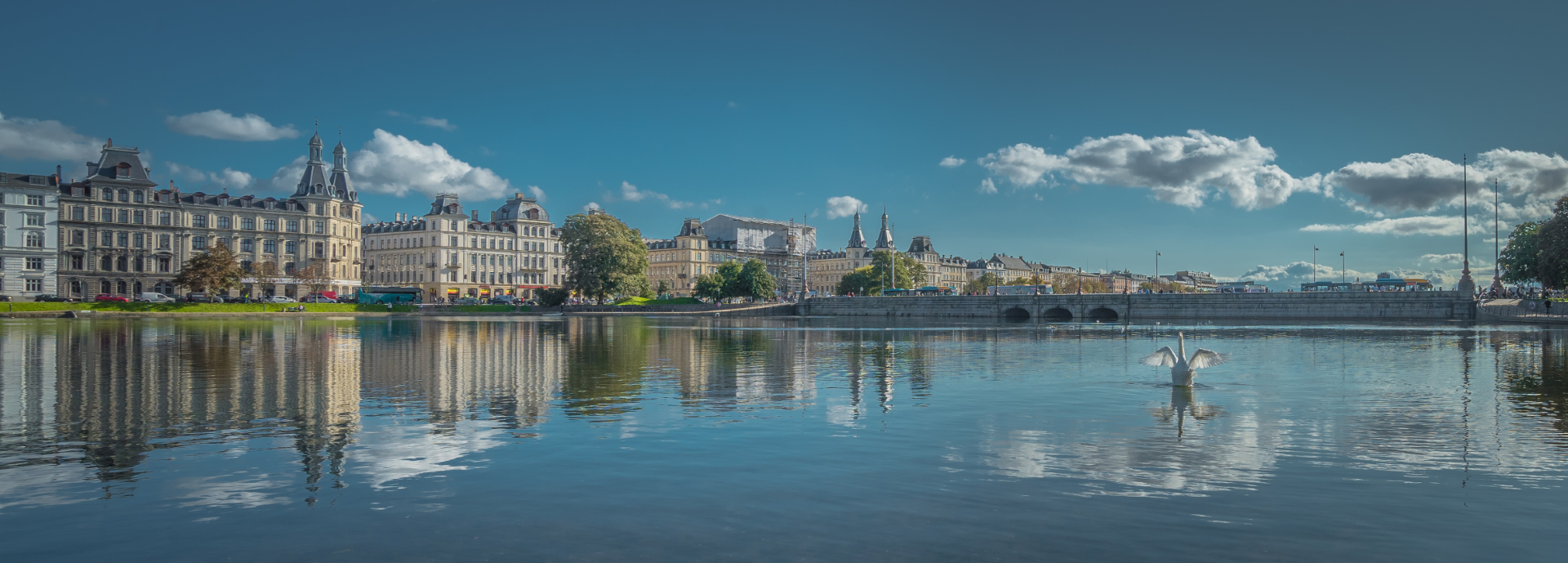 The next image is a low-light shot also using the new lens. Here too I'm very happy with the sharpness. Any non-sharpness is due to it being a very windy evening. Low-light was my big problem with my old camera and old lenses. You couldn't see where a blade of grass started and ended. It was all just an indistinct mess. Much better here, in my own opinion.
The next image is a low-light shot also using the new lens. Here too I'm very happy with the sharpness. Any non-sharpness is due to it being a very windy evening. Low-light was my big problem with my old camera and old lenses. You couldn't see where a blade of grass started and ended. It was all just an indistinct mess. Much better here, in my own opinion.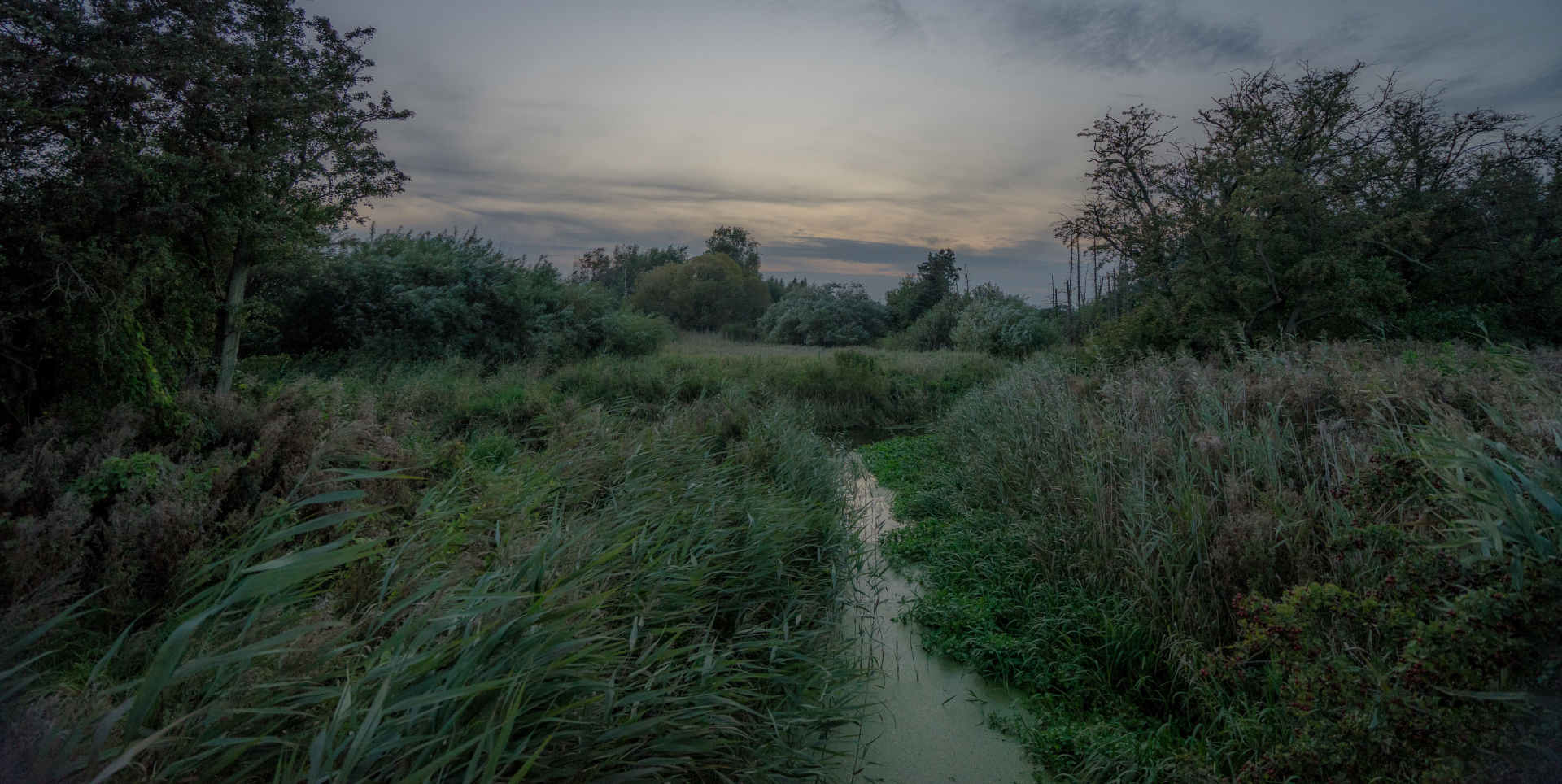 So while my new lens is the most important reason my photography has taken a turn for the better, there are other reasons, reasons that actually have more to do with post-processing than shooting.
So while my new lens is the most important reason my photography has taken a turn for the better, there are other reasons, reasons that actually have more to do with post-processing than shooting.
About a month ago, I finally lost patience with my old laptop that I normally used for photo editing. It was slow, constantly died from BSOD, and it was running out of disk space. At the same time, the price dropped on a laptop I'd had my eye on that would be a gigantic step up for me. So, I convinced myself I'd just saved a lot of money by not having to buy a wide angle lens and hit the "buy" button.
And what a difference it has made. Never mind how fast it is and that it has made Lightroom a breeze to run, the screen has made me realize that for all these years, I've been doing my post-editing all wrong. Looking at my pictures that were edited on my old computer, I see how awful they look. Way too much contrast, too much black, too much clarity. So, no wonder I'm not a rich and famous photographer! My pictures were ugly! That changes now.
Last... and maybe least, but it still deserves a mention: a brand new piece of photo editing software has given certain pictures the last oomph that really make them stand out. It's called Luminar and still only exists in a beta version for Windows (I think a fully developed version exists for Mac). While I love Lightroom and have no plans to abandon it, it's mostly suited for - and this may be due to my lack of skills in using it - a nice and proper result. Nothing wrong with that. But it takes more than that to get attention. Especially when you don't live near waterfalls, mountains, volcanoes, rivers, wild oceans, or whatever else will give you a natural advantage in photo contests such as the ones I frequent at ViewBug and GuruShots.
So here's a before and after example of a plain Lightroom edit and a Lighroom edit enhanced by Luminar. The first image is probably closer to "real life" than the second, but real life usually won't win you many "wow"'s and "oohh"'s.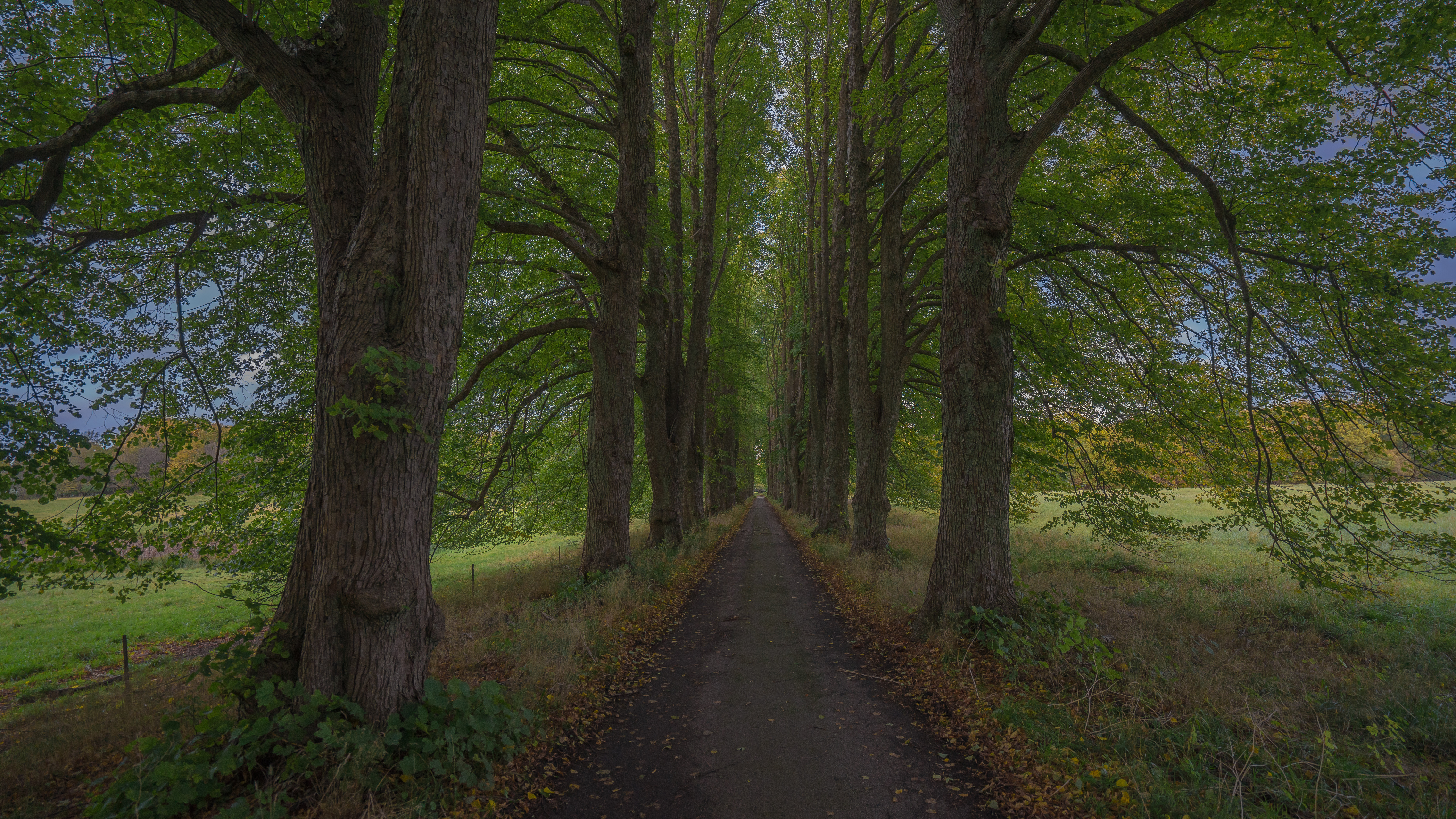
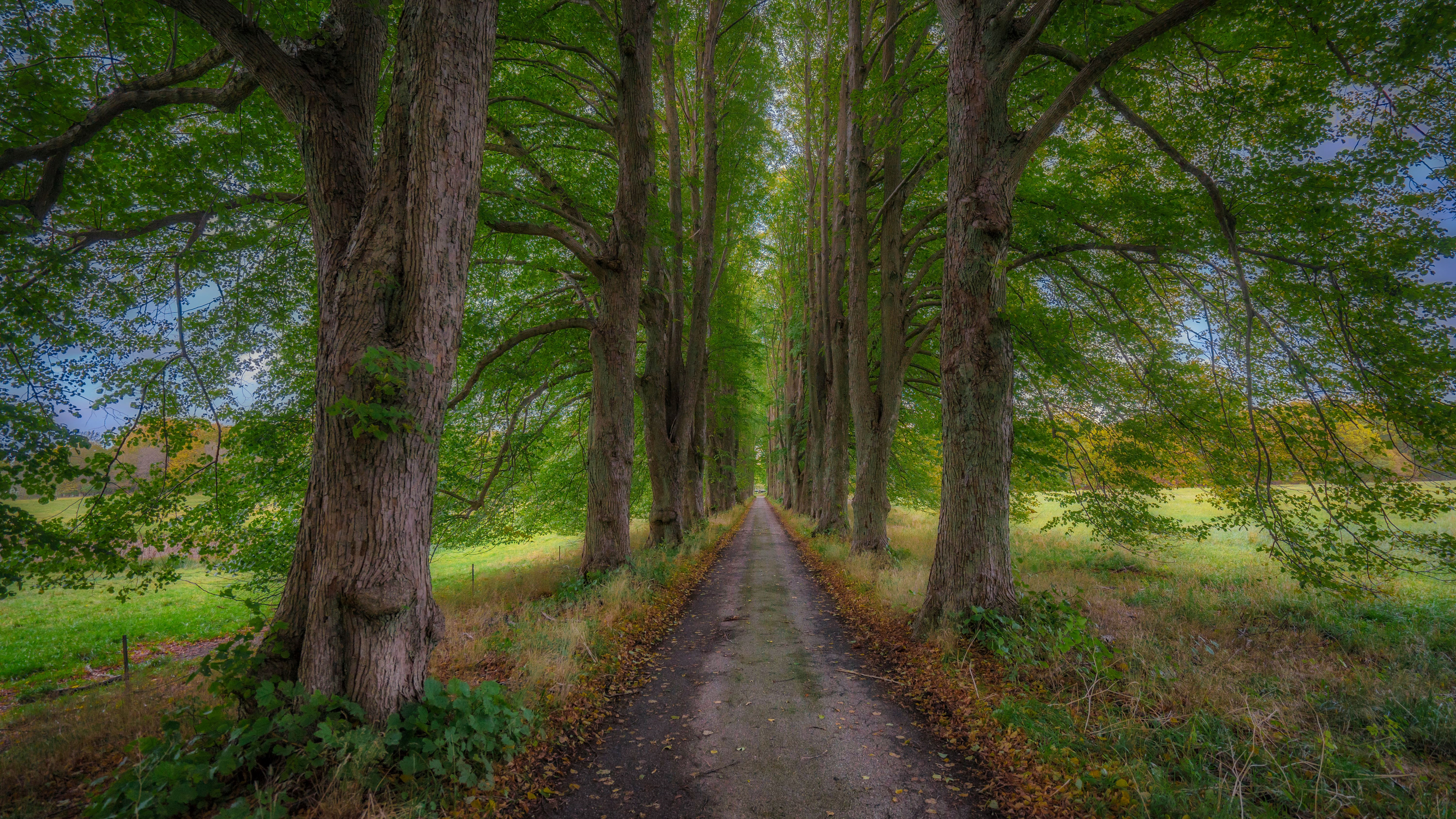 And just for the record, I don't post-process my images based on what I think will win contests (I won't win any contests, anyway), but mostly based on my own tastes. So, yeah, I prefer to look at the Luminar version, too, just like the majority of contest voters.
And just for the record, I don't post-process my images based on what I think will win contests (I won't win any contests, anyway), but mostly based on my own tastes. So, yeah, I prefer to look at the Luminar version, too, just like the majority of contest voters.
So, agree or not, in my own mind my photography is improving and that's really another reason I want to go out there and shoot - even if it's the same things I shoot over and over. It's invaluable practice for when I finally go to the really great locations.
I may not spend every other weekend going to a new location to take pictures. I would like to do much more of that, but so far that's just not happening, with real life and laziness being much too time-consuming.
Fortunately, for someone who doesn't get out as much as he should, I can only appreciate the opportunities that my immediate surroundings offer in terms of photogeneity. And when I say "immediate surroundings" I mean stepping out the door to the patio and walking 30 meters across the little child-friendly street on which we live. From there I have a westward view of our neighborhood, which in that direction consists of a green area, a bike path, trees, a housing development that is actually quite beautiful in my opinion... and, last but not least, sunsets. Lots of sunsets. From April to September or October, we are blessed with some pretty spectacular sunsets on evenings when the cloud cover allows it, which during those months happens on a fairly regular basis.
This is what happens on those evenings: orange, yellow, purple, pink, and red colors fill up the sky above the aforementioned housing development. I get up from the couch, grab my camera, and run out to capture it before it goes away, much to the confusion of my cats who will join me out there wondering what the hell I'm doing.
Back inside on the couch, I will glance out the window again and realize that, whoa, it's now twice as beautiful as it was five minutes ago. So once again I get up and go out there while frantically adjusting the ISO of the camera to the now slightly darker conditions.
This repeats two or three times a few times every month, so it's no wonder I end up with a few pictures that may be somewhat.... how can I put it? ...overlapping. But then again, look at the below selection of images, all from 2017. To my own eyes, there are worlds of difference in how those sunsets manifest themselves, and I truly feel all pictures are worthwhile additions to my collection.
I guess the moral of the story is that if stepping out your patio door is all it takes to create something unique and beautiful on a regular basis (and of course, that part is my own opinion... you may think I'm taking the same picture over and over), you don't have to feel bad about not being able to go to a new location every other week in order to be a great photographer. A little change in the cloud cover or lighting conditions in your own little neighborhood and you are well on your way to something fresh and interesting.
Still, don't take this as a call to stay home, but more like a comfort to you if, for a while, getting out there in the world, for whatever reason, is just not happening.
Photography has been slow lately. The last several weeks have been ridiculous weather-wise, plus I've been sick in the last week. I'm itching to get out there, especially since I unexpectedly became the owner of the landscape lens that I didn't think I'd be able to afford for a year at least, a lens that will, without a doubt, push me to the top of the landscape photography elite! More of that in a later post, of course. Today is all about catching up and talking about my summer vacation before it becomes but a distant memory.
If I had been doing this blog for the last 10 years, you might have noticed by now that most of my longer vacations are spent in the US, or Northern Idaho to be more specific. Not this year. This year we settled for a four-day getaway to Edinburgh, Scotland. I had never been to Scotland before, but it felt like a country that would suit me well when it came to things like climate, culture, and not least photographic opportunities.
I was not disappointed by any of those things. Of course, I could have done without the downpour that ruined part of our big bus tour to Loch Ness and the highlands, but oh well. We still had fun.
Anyway, after much consideration I have decided to simply post - and talk a little bit about - my three favorite pictures from the trip, and then add a slideshow video that will give you more of an impression of the whole experience.
The first image was taken on our first night in Edinburgh. It shows a canal near where we stayed. Apparently, the UK is full of these canals with their canal boats (which you will see more of in the video). This quay area with its modern architectural buildings and rustic boats made for a beautiful scene during the sunset, and with fantastic low-hanging clouds to add a little drama.
We returned the next evening because I thought I could do better, but the light wasn't as good, and in the end this image just turned out better than all the others.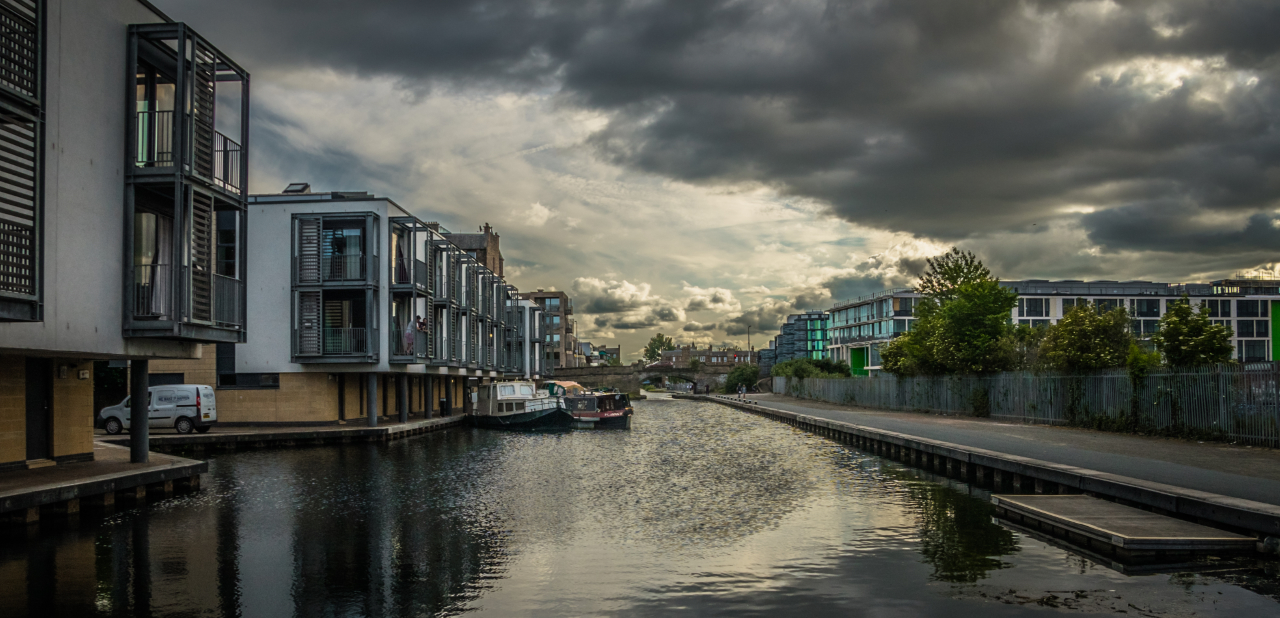 Below is, in my own opinion, a wonderful shot of Edinburgh Castle overlooking the connecting park. It was taken as the sun was setting and as we were walking back to our hotel after a long, long day of exploring the city. Our explorations had taken us all around downtown Edinburgh, including to, and inside, the castle itself. Needless to say an iconic construction like Edinburgh Castle offers countless photo opportunities, and with my usual, "better take 300 pictures too many than one too few"-approach, I couldn't have missed too many of them.
Below is, in my own opinion, a wonderful shot of Edinburgh Castle overlooking the connecting park. It was taken as the sun was setting and as we were walking back to our hotel after a long, long day of exploring the city. Our explorations had taken us all around downtown Edinburgh, including to, and inside, the castle itself. Needless to say an iconic construction like Edinburgh Castle offers countless photo opportunities, and with my usual, "better take 300 pictures too many than one too few"-approach, I couldn't have missed too many of them.
However, for all the architectural details and historical magnificence that the closeups revealed, this image, with the lush, green park contrasting the ragged castle walls, tells the story of how the city is, and always has been, dominated by the presence of the castle, for better or worse.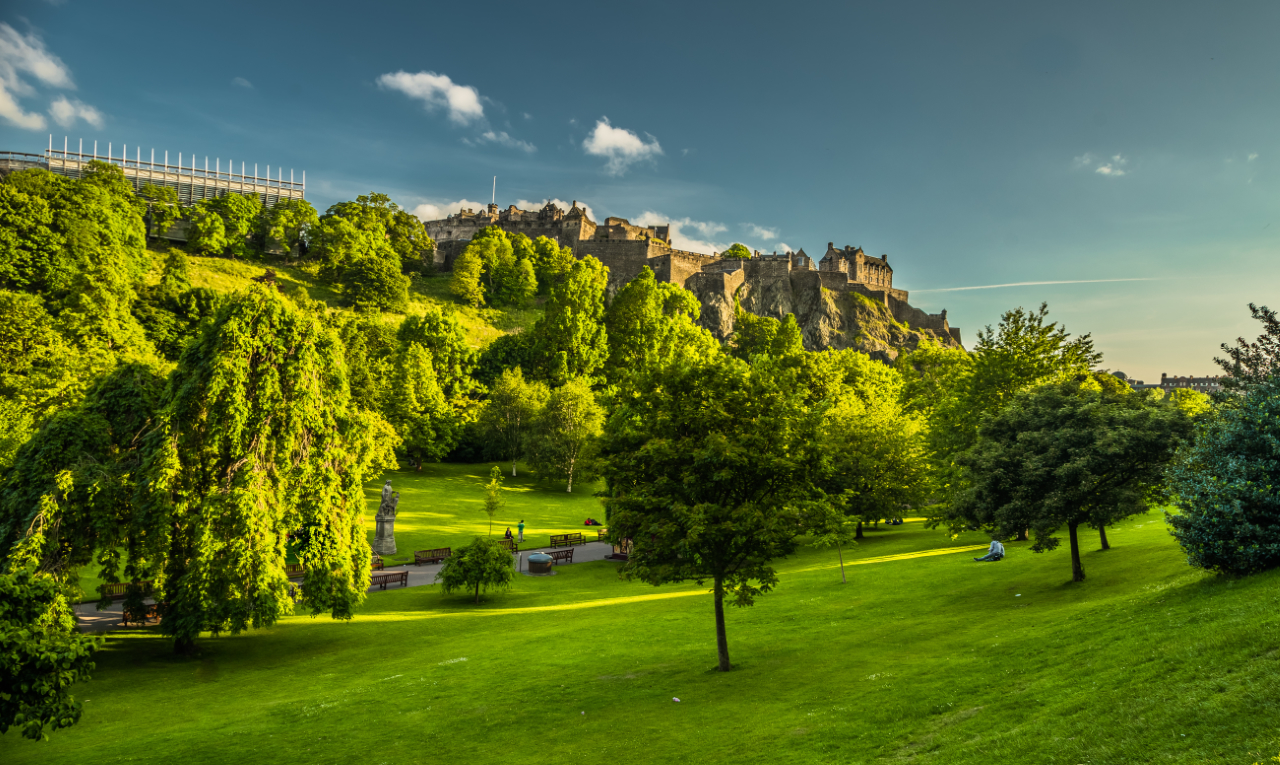 The last of the three images was taken on our last night in Scotland which offered both the photographic and emotional highlight of our entire trip. Almost as an afterthought we decided to climb the famous Arthur's Seat hill overlooking Edinburgh. I had been on one of the neighboring hills two nights previously, and while that had been a good experience and well worth it, I wasn't totally blown away and would not have been too disappointed if we hadn't made it up to Arthur's Seat.
The last of the three images was taken on our last night in Scotland which offered both the photographic and emotional highlight of our entire trip. Almost as an afterthought we decided to climb the famous Arthur's Seat hill overlooking Edinburgh. I had been on one of the neighboring hills two nights previously, and while that had been a good experience and well worth it, I wasn't totally blown away and would not have been too disappointed if we hadn't made it up to Arthur's Seat.
Well, I should have been! Arthur's Seat was a whole different experience. For one thing, you felt like you were at the top of the world. You could see for miles in all directions, and even with loads of other tourists up there, you had a sense of detachment from the real world. I could have stayed up there forever, but good thing I didn't, because then I wouldn't have gotten the below image, which was, in fact, not taken on Arthur's Seat (check out the video for that) but on the walk back down from there.
As soon as I spotted the old ruin a little off the track, I knew I was about to take some of my all-time best photos. Of course, there were plenty of ways I could have screwed it up, but short of a colorful sunset, which we just couldn't sit and wait for, and without a tripod to enable long exposures, I think I did about as well as could have been expected, which was pretty damn good. The dramatic clouds are a fine replacement for a sunset, and the image just has a feel of raw, ancient history of kings, wizards, religion, and long lost culture.
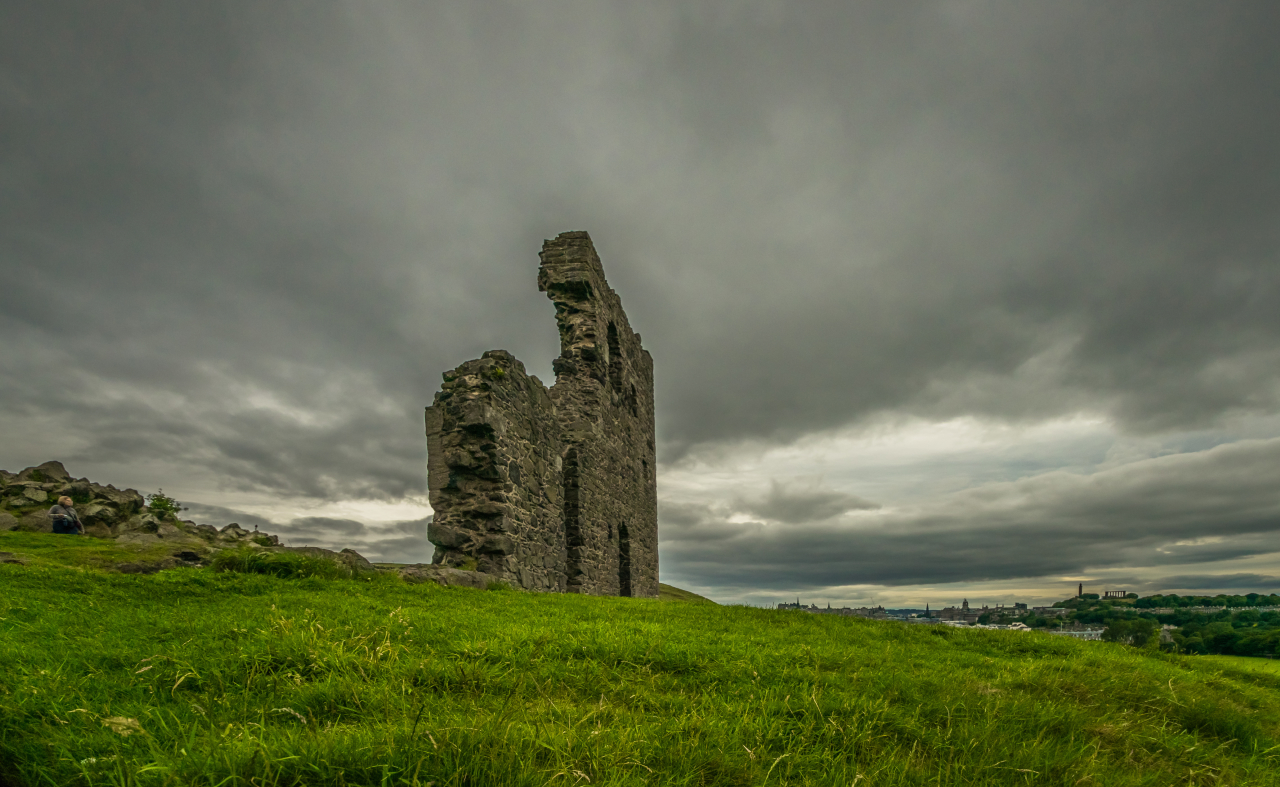 Of course, you didn't really expect me to only show three pictures from Scotland, now did you? The only reason I can limit myself to that is that I also made the below slideshow featuring another 80 or so images from four amazing days. You may want to make the player a little bigger and you definitely want to turn up the sound so you don't miss the beautiful music.
Of course, you didn't really expect me to only show three pictures from Scotland, now did you? The only reason I can limit myself to that is that I also made the below slideshow featuring another 80 or so images from four amazing days. You may want to make the player a little bigger and you definitely want to turn up the sound so you don't miss the beautiful music.
I once read that, according to science, the color green has a special effect on the human brain. Due to our origin in the jungle and other green surroundings, even for today's modern people, the color green unconsciously equals the presence of water and the absence of starvation, which again soothes the brain, gives us peace of mind, and makes us relax.
I believe it. I can feel it. Being in a green forest is fuel to my soul. I can't say for sure if it's the color green, or perhaps the quiet, or the smell, or a combination of it all. What I do know is that I live in a country with no mountains or rivers, but what we have instead - for a few weeks in May - is the most beautiful shade of green your eyes can behold. That's when the leaves of the beech trees burst open in cascades of light-green color that can take your breath away as much as any high peak or waterfall in more mountainous areas of the world . At least, that's how I feel, and it seems like the older I get, the more I feel it.
Of course, my interest in photography also helps me appreciate this special time of year even more, so it's no wonder that as the time draws near, I become anxious and look at the weather forecast to make sure I get out there on just the right day and just the right hour when light and color form a perfect synthesis. Well, at least according to my own feeling. I'm not assertive enough to claim I have the exact answer... And besides, sometimes work, your state of mind, and life in general have more influence on when you get out there with your camera than anything else.
What I do know is that - unlike the case with much other landscape photography - the time of near sunset or the blue hour are not the optimal times for green leaf pictures. The lack of light during those times of day prevent the strong green color from showing to the best advantage. The sun needs to still be - not necessarily high in the sky - but well above the horizon. The forest itself will ward off any harsh shadows and too much contrast that is otherwise a problem during afternoon landscape shooting.
This year I went out twice to try to capture the greenness at its peak. The first time, on May 12, was possibly a few days too early as, in many places, the leaves were still a tad too sparse. Still, I came away with some excellent results from a spot I've had success at before: a particularly beautiful forest edge near the Frederiksborg Castle Garden.
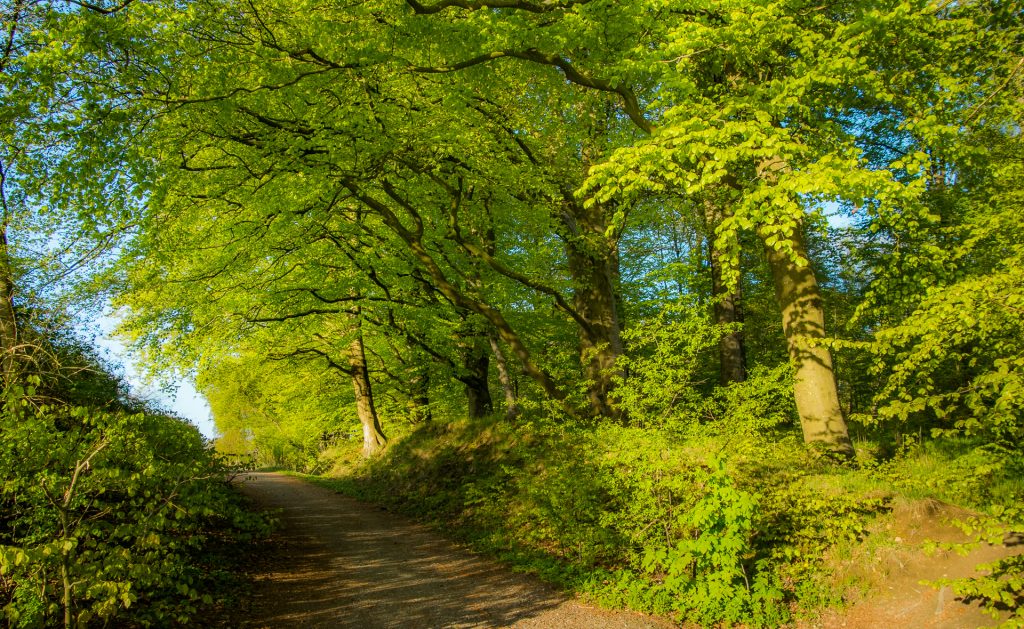
Still in the same neighborhood, this may be my favorite shot. The light coming in from the right highlights the exquisite green color. But this is about as low as the sun should get before there's not enough light.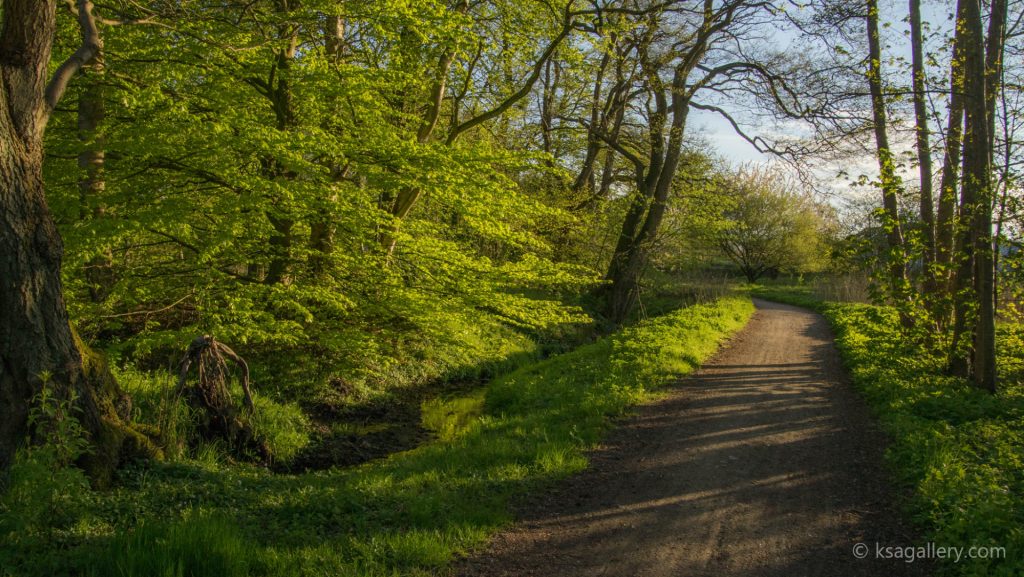
And yet, here's a picture taken several minutes later. The sun is still above the horizon, but it was becoming more difficult to emphasize the greenness. This is an HDR put together from two different exposures.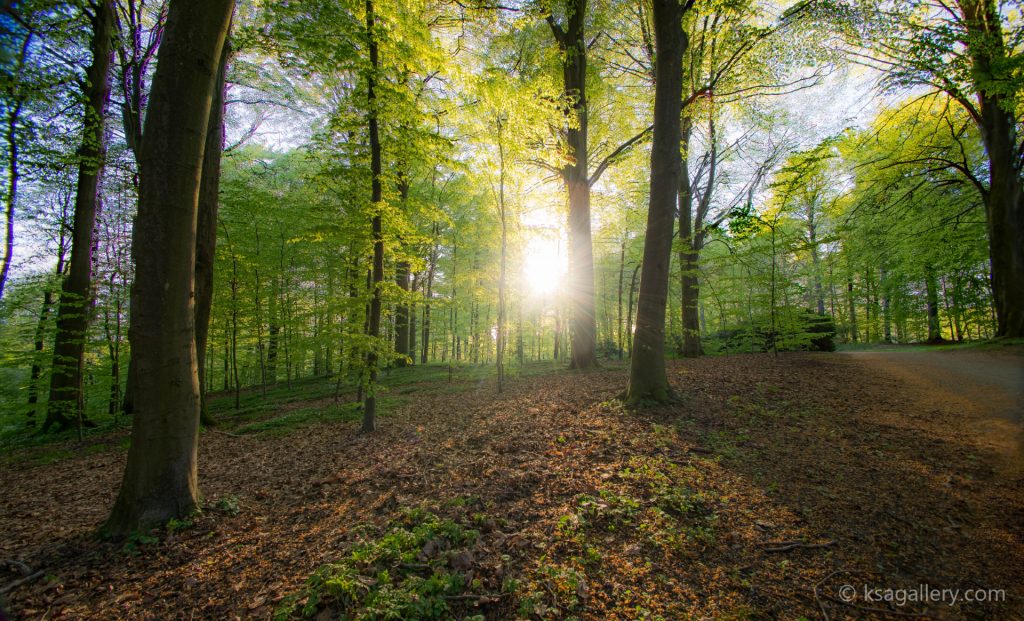 Realizing it was becoming too late to catch the green leaves, I headed for the castle where I took some really nice long-exposures, but that's for another post.
Realizing it was becoming too late to catch the green leaves, I headed for the castle where I took some really nice long-exposures, but that's for another post.
Instead I went out again a week later - a little earlier in the day and with the leaves now fully expanded and still with all the brightness preserved.
The below photo is my favorite one of the day. Perhaps because it is the one that most accurately reproduces the actual color that you see out there.
The last one is another HDR with some nice shadows.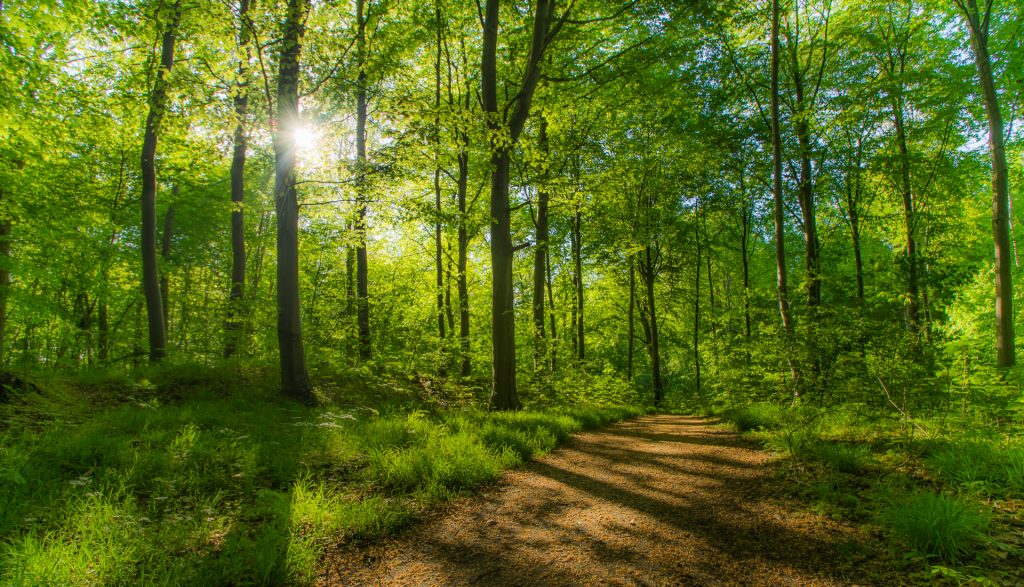
As with all pictures I post on this blog, these too have been submitted to some more or less heavy post-processing. Sometimes, I admit, the post-processing I do is to make the scenery look a little more... shall we say... "colorful" than perhaps it actually was. Here, the post-processing has served only one purpose: to make the pictures resemble reality, as reality in this case cannot be surpassed. A raw unprocessed photo will not do reality justice at all - at least not with my limited skills as a photographer.
One trick to improve an image of a forest is to go against your instinct to make it as sharp and clear as possible. Unlike with just about all other pictures, I reduce clarity in Lightroom when I post-process pictures of forests. You should try it and see what happens.
The time when the green beech forest is at its peak lasts only about three weeks and is now long gone. After that, the leaves start to turn darker. They are still beautiful, but there is nothing like those three weeks to invigorate your spirit, soothe your soul, and take some awesome pictures!
In the last few months I've been feeling a growing itch in my body. I've been feeling that I had somehow hit a wall with my photography. While my eye for a good motif, and my ability to capture it, kept improving, my camera was becoming the weak link. I felt that even when I did everything right, using the right exposure, the right aperture, a tripod, etc., the technical quality of my pictures - especially in low-light scenery, left a lot to be desired. I started to look for a new lens, but realized my camera's A-mount system was an obstacle. The selection of A-mount lenses just isn't very good. Besides, my old trusty Sony A33 increasingly started to feel like a beginner's camera. I felt I had moved on from the beginner stage.
To make a long story short, I itched for a new camera. I knew it had to be a Sony again, but with the more future-proof E-mount system that would, at the same time, allow me to reuse my old lenses with an adapter.
After pretty thorough research - and with the advice from my more technically adept brother - I chose a Sony A7 II. While by no means Sony's top model, it has all the qualities I can realistically hope for with my budget. And with the right lens, there's no reason I shouldn't be able to take pictures that until now I could only dream of.
The right lens, however, is still a thing for the future. My economy can only take so much camera equipment in one month... possibly year. So for now I have to make do with my old lenses and the generic lens that came with the camera. And that's ok. There are plenty of new features in the camera itself that should help improve picture quality even with the old lenses. A lot of that, however, takes practice and studying, something I haven't done much of yet. So in my first few weeks of using the camera, I can't say that I have utilized its more advanced features much, just as I haven't pushed it to its limits by doing much low-light photography or other challenging exercises.
Still, the following pictures, all taken with the new camera and with the included lens, show a lot of promise of what it's capable of.
The first one is a well-known motif: Frederiksborg Castle, a stitch of six handheld images. Nice, sharp, and crisp.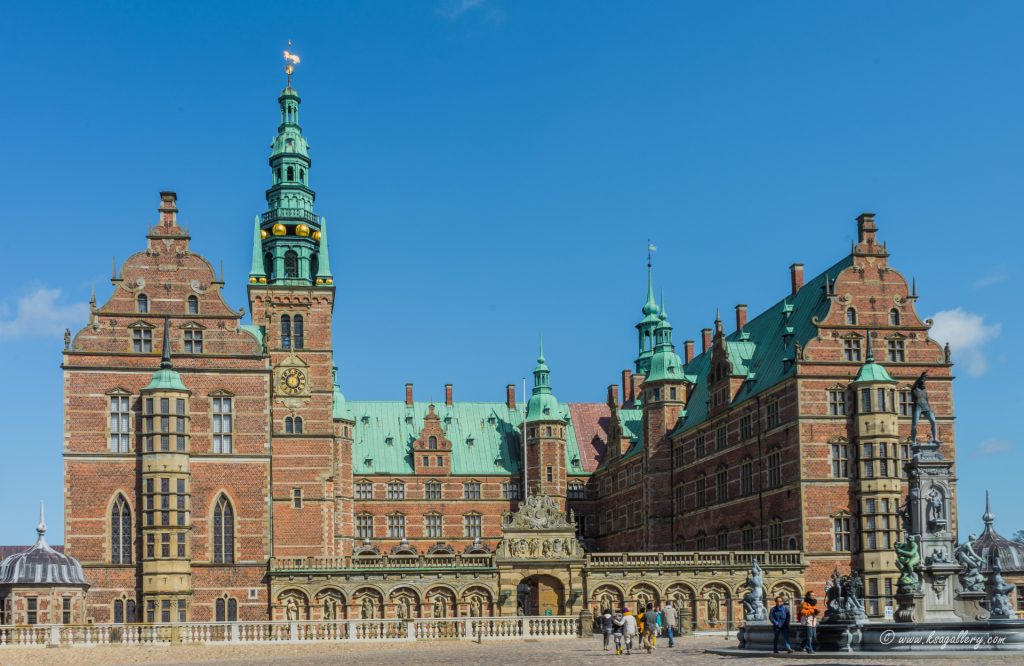
Seagulls at the harbor in Dragør during a photo excursion that I hope to write a separate post about soon. I wish the background of this shot hadn't been so messy, but I'm happy with the sharpness, achieved at only 1/160 second, in a burst of shots that made the memory card stumble to keep up.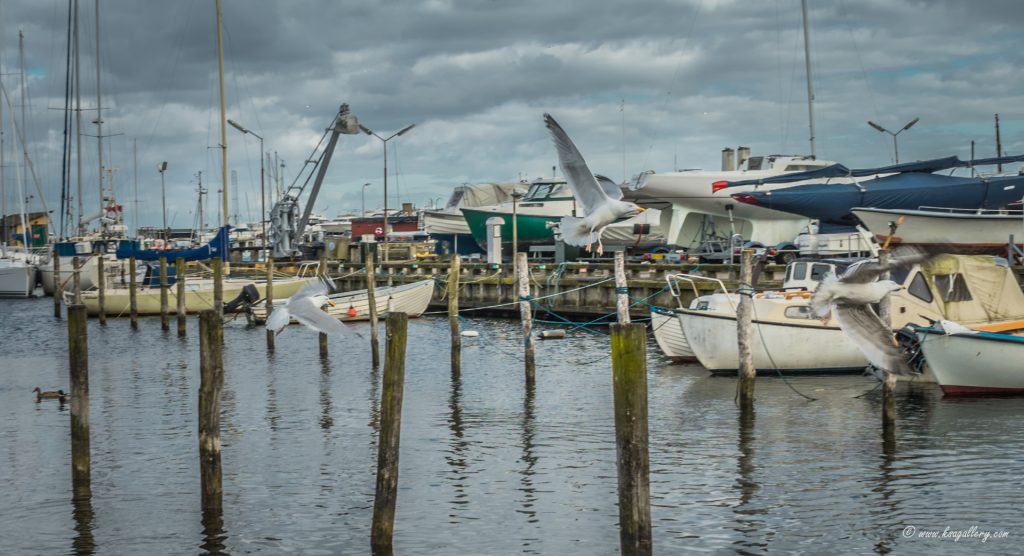
Another personal favorite of mine from my trip to Dragør. Again, notice the lack of blur, particularly in the waving flag. And boy, was it windy that day.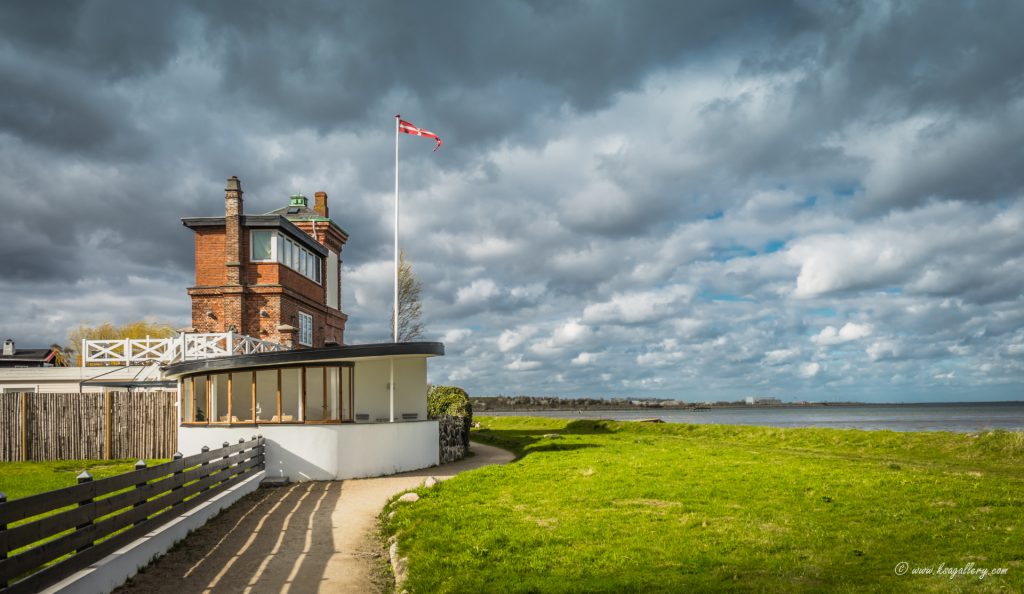
The only non-handheld picture of the bunch, and again from my Dragør expedition. That's me testing the app that comes with the camera and that turns your smartphone into an advanced remote control. Awesome! I always had trouble with remote controls for my old camera. This new smartphone system just worked. And the picture? There's a crispness about it that I just don't think I could have achieved with my A33.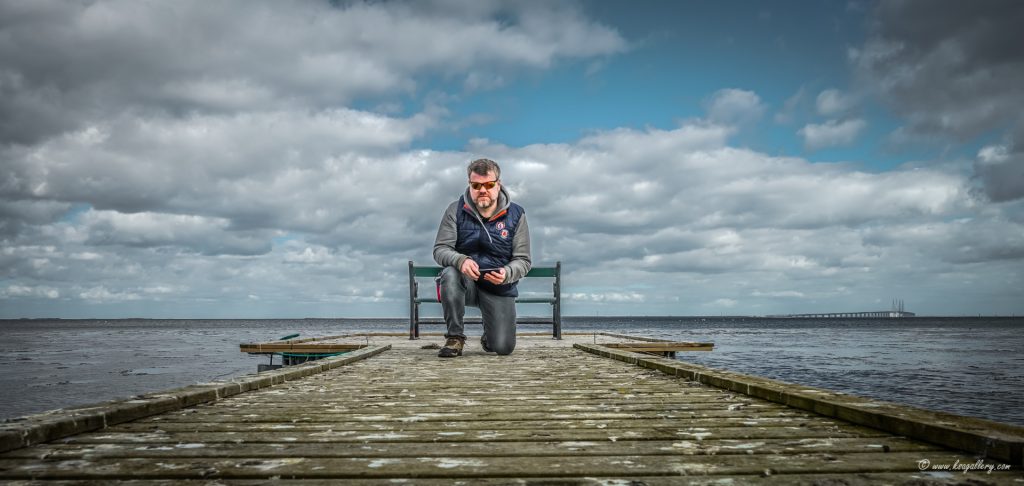
Next is my only attempt at low-light photography so far. Just the view from my backyard captured with a handheld shot at ISO 320 and 1/60 second. I think this demonstrates A7 II's anti-shake qualities in a big way. And the noise? There was none detectable. Definitely an improvement over my old A33.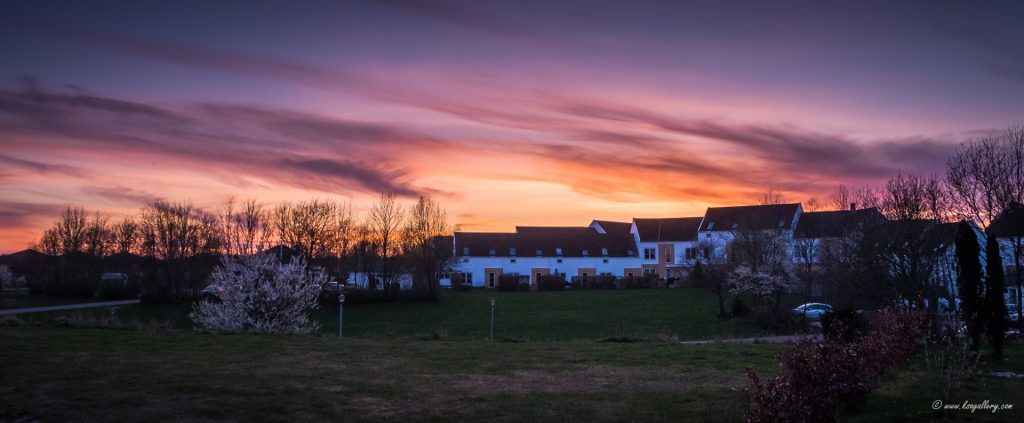
A picture of our neighbor's beautiful cat Ollie. Here I have experimented with A7's manual focus, adjusting the focus to the cat's eyes, something that wasn't even possible with my A33. Yes, I admit, I enhanced the eyes in post-processing, but still...
One of my favorite pictures that I have taken so far, not just with the new camera, but... like... ever. I don't know if it tells a lot about the camera, but I'd like to think I couldn't have achieved quite the same result with my A33. All I know is that I had to include it here because I just hit the nail on the head with this one, if I say so myself.
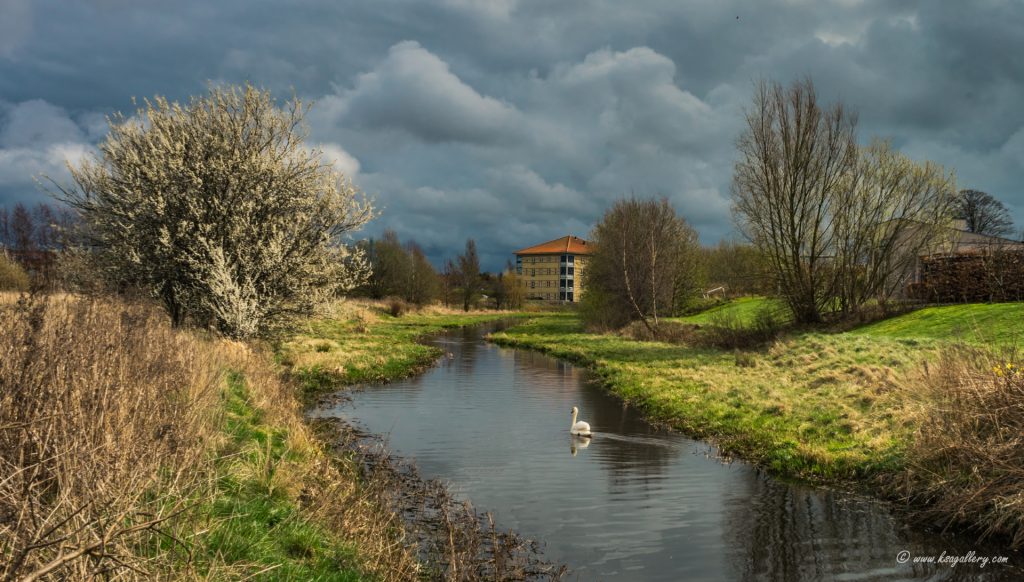
Well, the days are getting longer, the beech trees will explode in green within a few weeks, life is returning to nature, people are coming out of their houses, and I will be there to document it all with my A7 II. So keep an eye on this spot. I can feel this will be an extraordinary photo year.
I know, March isn't over yet, but having just enjoyed a one-week March vacation that offered a few opportunities to get some shooting done, I felt it was time to make a status report.
Before my vacation I had grand plans to drive or - in the spirit of spring - ride my bike all over the region and capture nature as it slowly sheds its winter harness.
Well, that didn't quite happen, but I did get out once on my bike. I had high hopes for an area about 7 kilometers away where I'd never been before. Being in abysmal shape, I barely made it there. There was a cold wind blowing, and tons of little hills that seemed to only go up. I had to make several stops on the way to catch my breath check the map and take pictures of the pretty scenery.
In fact, my favorite picture of the day - and perhaps the whole week - was taken at the foot of a hill that seemed like a good place for a short break. It was taken with my cell phone as my real camera was still packed away in its bag, and I couldn't be bothered to get it out. As a true artist I had to take a risk by standing in the middle of the road for a couple of seconds. It was a very quiet road, but behind me was a curve and an underpass that would have given drivers only a short time to react to my presence. Fortunately, no cars appeared, and the shot was in the can and turned out better than expected, although it worked best in black and white.

As it turned out, that would be one of the only pictures of the day worth sharing. The area I'd had in mind was a disappointment. Just some typical Danish winter forest and a swampy meadow with no interesting angles, colors, or lines. The below picture - a cell phone panorama - turned out ok though.
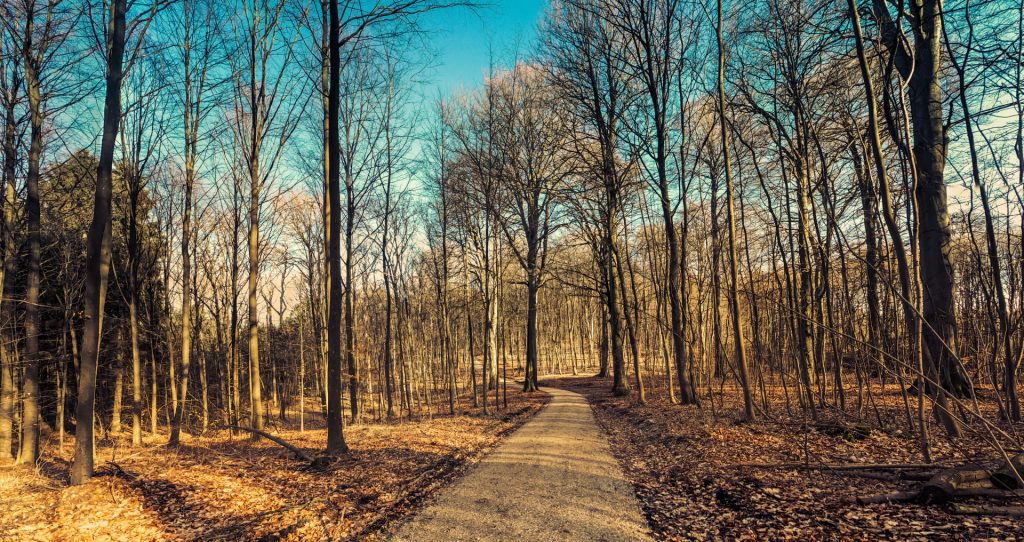
The day before my somewhat anticlimatic bike ride, I had a chance to explore our local castle again. It offers endless photo opportunities, and while I have been known to complain about our nearby landscape's lack of character and photogeneity, I am grateful to live in close vicinity to such an architectural pearl. I'm nowhere near done with it. I haven't even shot it during a real beautiful sunset yet. Soon!
My third and final photo outing during my vacation also went to familiar territory: the Strødam enclosure, where I've posted numerous pictures from before. I keep coming back, because it is actually the exception to the rule that I live in a boring area. I love it there, and despite no great light or other redeeming factors, I was quite happy with a few of the pictures I went away with.
So that was it for my vacation. Not quite what I'd hoped for, but March is still a little early to expect miracles in your landscape photography.
Iceland is all landscape photographers' dream travel destination, and back in September I was fortunate enough to spend all of 20 hours there in connection with a return flight from the US to Denmark.
The deal with Icelandair was the following: get an insanely cheap flight to US and in return spend a little time - and money - in our beautiful, volcanic country. I figured, why not? I knew that whatever I saved on the plane ticket, I'd probably spend in Iceland, but the prospect of getting to shoot some of the most fascinating landscapes in the world intrigued me.
So after a little research I booked a six-hour bus tour covering what's known as The Golden Circle, the southwest corner of Iceland where spectacular scenery is as plentiful as it is accessible. I was ready.
I arrived in Reykjavik at 6 o'clock in the morning on September 20 2016 after a seven-hour flight from Seattle. Having been unable to sleep on the plane, I was beginning to have some slight doubts about this whole endeavor. It didn't help that I had six hours to kill before the bus tour even started, 50 minutes of which were spent on a shuttle bus going from the airport into the city of Reykjavik. A lot of the landscape that we passed on the way looked rather bleak, to put it mildly. The clouds were almost as black as the volcanic soil. Even the rays of sun seemed hostile, like big, extra-terrestrial search lights sweeping the ground looking for surviving humans.
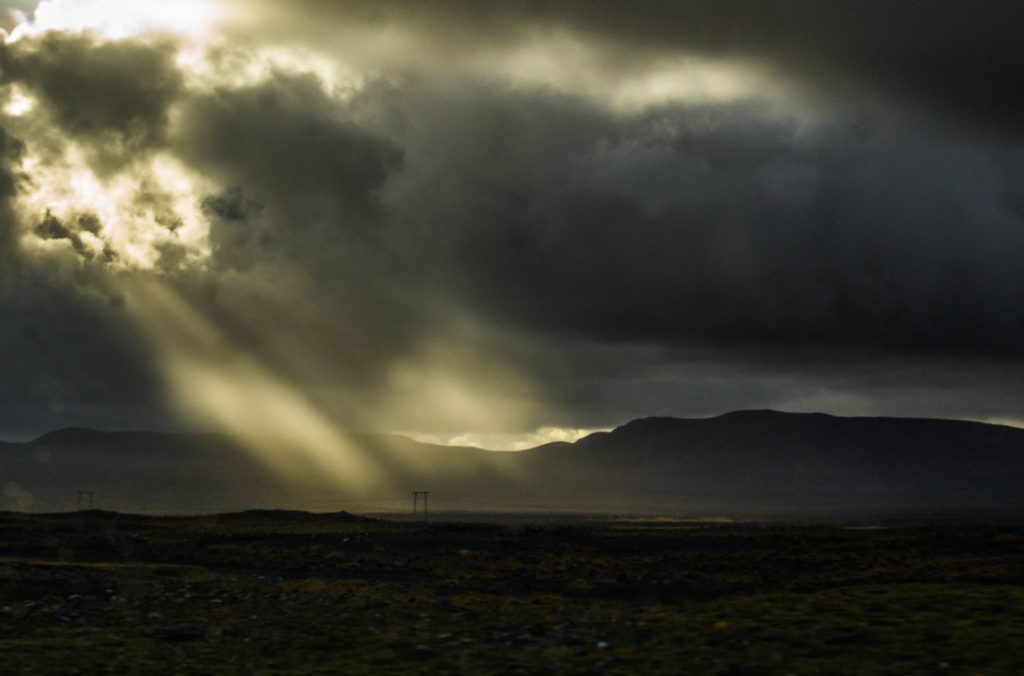
Was this dark, bare landscape really the magical Iceland I had heard so much about? At this point I wished I'd just spent $200 more on that plane ticket and gone straight home to my warm, Danish bed.
Well, it was too late for regrets. I had to make the best of it. That included walking a couple of kilometers from the bus depot to downtown Reykjavik. If the country had indeed been taken over by aliens, a good bet was that their overlord could be found inside that dome in the background of the below picture.
I didn't go to find out, but continued the opposite direction and, with the help of Google Maps, soon made it to the city center. Reykjavik is much bigger than I imagined and seems to be going through both some serious growth and an architectural update, including the brand new city hall as seen here:
After a 30-minute pit-stop at the local public library (always to the rescue when you most need them), I was ready for a little more exploration and found my way to a park rising above downtown and offering this view of the harbor and the new performing arts center Harpa.
Then the rain started.
It had been threatening to rain since I'd left the airport. I had felt plenty of drops and hoped it wouldn't amount to more than that, but as I continued my walk through the city, the rain started pouring from a steel gray sky from which the dots of blue and rays of sunlight had now completely vanished. I had to find refuge in a covered bus stop and sat there shivering with cold for an hour while bus passengers came and went. The fact that I didn't take a single picture of life buzzing by on this busy Reykjavik street tells you all about my state of mind. I was hungry, tired, wet, jet-lagged, sore, and just plain miserable.
Finally, the time came when I had to go to the pick-up place for the Golden Circle bus tour. A small shuttle bus took me back to the bus depot where the actual bus departed from, and we were on our way. When I say "we" I mean myself and about 10 other tourists, the driver, and a male guide who, in his own quiet, understated way, entertained us with jokes about volcanic eruptions and all the other hard conditions Icelandic people had to endure.
The first part of the tour went through some more bleak, and yet fascinating landscape, where overland pipelines transporting thermally heated water criss-crossed the treeless hills, and electric powerlines towered above us like deadly steel triffids.
Things became a little more hospitable when we picked up two more passengers at an idyllic horse breeding ranch. The stumpy, long-haired, and extremely tough Icelandic ponies are one of the country's primary exports, and they supposedly cost fortunes.
The first real stop of the tour came after about an hour's drive (during which I think I dozed off for a few minutes, the first sleep I'd had in close to 24 hours). It was the famous Haukadalur geyser area where a geyser named Geysir actually gave name to... well... geysers.
Although I have experienced geysers several times in Yellowstone National Park, steaming water shooting out of the ground will always be one of the most awesome natural phenomenons you can witness. A short let-up in the rain even made it possible to get some decent pictures, and unlike most geysers in Yellowstone, here you didn't have to wait hours, days or months for an eruption. This particular specimen knew how to please a crowd and released its load of boiling water every 10-15 minutes.
Before the next stop, we passed through a landscape that was turning more and more breathtaking. There were no huge mountains chains on the horizon - in fact, in places it was almost flat - but rivers and creeks were everywhere, framed by lush green colors and this characteristic soft icelandic light that despite the cloud cover still felt quite tangible.
Having not really studied the Golden Circle in advance, nothing had prepared me for what came next. Sure, the guide talked about a waterfall. I knew waterfalls. I'd seen tons of waterfalls two weeks previously in Canada. They didn't come much better than that.
Except, they did. After a short hike from the parking lot, what revealed itself in front of me was one of the most magnificent sights my eyes had beheld in my 47 years on Earth: a waterfall the size of a 10-story apartment block. All the fatigue, misery, and pain that the day had been so full of vanished in a split second, and all I could think of was how to capture this natural wonder with my little, utterly insufficient piece of man-made technology called a camera.
You'd think the Gullfoss waterfall would be a slam dunk, but to be honest, while I'm fairly happy with the result, it does not tell half the story of what it was like to stand there. You don't truly sense the sheer magnitude and power of all that water roaring through the canyon.
Part of the problem was not my photography skills, but the fact that the surrounding landscape was so bare. The waterfall was all there was. There was nothing to put in the foreground, nothing that could work as a scale indicator, and no sunshine or sunset to enhance the colors.
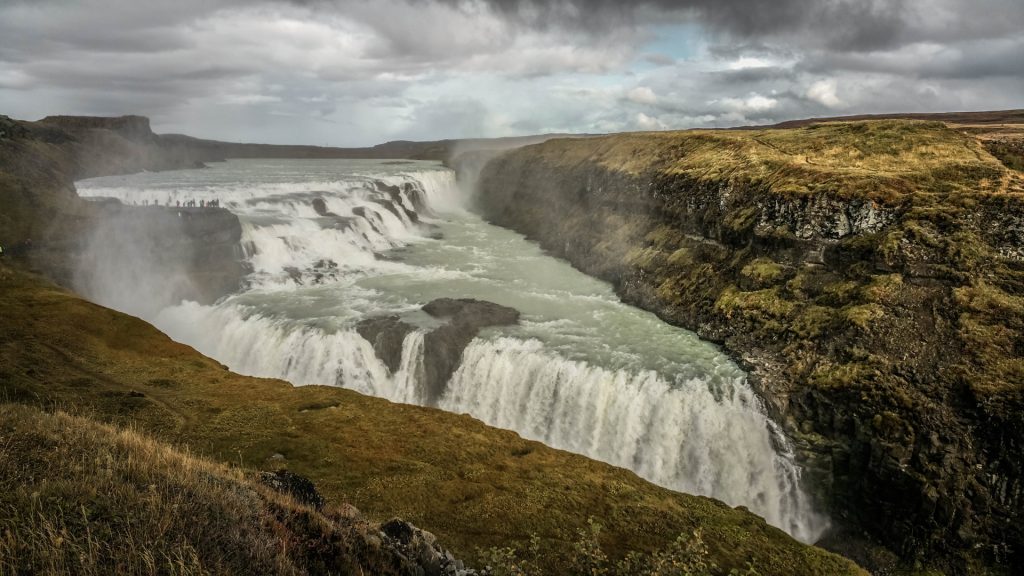
Perhaps my best capture of the Gullfoss waterfall is actually the stitch of 2-3 images, which is what you see below. I had followed a trail down to the top shelf of the waterfall where I snapped several images, including a few long exposures. My tripod was safely packed in my checked baggage at Keflavik Airport, so I had to place the camera on the rocks and use a 2-second shutter delay.
Another challenge was that the rain was starting to pick up again and that we only had about 30 minutes before departure. So I worked fast and frantically to take all the pictures I could, using two different lenses, two different cameras (my cell phone being the other one), and all kinds of settings to cover all my bases. I was actually surprised and proud of myself for not screwing things up and dropping a lens into the raging river. The last few years of frequent picture-taking has paid off. I know my camera and can almost work it in my sleep, even when things get hectic. This next picture tells you all you need to know about the conditions I was working under.
As it turned out, I was back on the bus before most everyone else, but I was happy and elated and knew I'd done what I could under difficult circumstances. I also knew that no matter what had happened earlier in the day and what would happen from then on, my Icelandic detour would have been more than worth it.
When we arrived at the last stop an hour or so later, it wasn't just raining. It was pouring. Hard. I put my camera under my vest and walked with the rest of the party up to where the tectonic plates of Europe and North America happened to meet. Or rather, separate. It was also the location of an ancient viking parliament where the earliest Icelanders met to make decisions or put criminals to trial.
Under normal circumstances my camera shutter would have been working non-stop to capture every detail of this historically and scientifically significant spot. But the pouring rain meant I could only get the camera out from under my vest for a second or two at a time, or just enough time to point and shoot. It's a miracle I got any useable pictures at all.
The below image is the actual rift between the two continents. In some places it's no wider than you could stand with a foot in both Europe and North America.
While not a photographic highlight of my Icelandic adventure, the visit to Thingvellir, as the area is called, was still a mindblowing look into the past, both geological and historical. Moreover, it was a perfect end to a bus tour that, at one point I wished I'd never booked, but very soon realized would be an experience of a lifetime.
At this point I packed my camera away. I did take a couple more pictures with my cell phone on the way back to Reykjavik, but nothing spectacular. Back at the bus depot, I had to wait a couple of hours for my ride back to the airport.
After arriving at the airport, the rest of the evening until my 1 a.m. flight was spent picking up my luggage from the storage place a kilometer from the airport terminal (a distance I had to walk to and from in more pouring rain), queuing up in the only passenger queue I could find (the wrong one, it turned out... all the German voices should have tipped me off), walking what felt like three miles through the airport to my gate (I'd always thought Keflavik Airport was fairly small... boy, was I wrong), sitting in a chair at the gate for two hours unable to sleep, then lining up to board the plane only to be told it would be 30 minutes late, and then finally, FINALLY dropping into my plane seat after having walked 20,000 steps and been awake for about 35 hours.
I may have dozed off for an hour or so during the flight, but I would not get any real sleep until I was all the way home 5-6 hours later, more dead than alive, and the last 40 hours seeming like a dream - except, I had the pictures to prove that it happened.
The other day I mentioned how depressing and uninspiring our current weather is. It's all a gray mass of gray and has been so for weeks. This is actually one of the reasons we survive the short days here in the Scandinavian hemisphere: nightfall at 3:30 in the afternoon is a relief compared to the gray mush we spend the day in.
Anyway, needing some exercise today and with no intention of turning it into a photo excursion, I saddled my bike and rode into the grayness, armed only with my cell phone. But of course, I had not gone for more than 10 minutes before I caught sight of the most beautiful and depressing abandoned... well, actually, I don't know what it used to be, but anything abandoned is worth a picture, so off the bike I hopped and used my cell phone to capture the below likeness.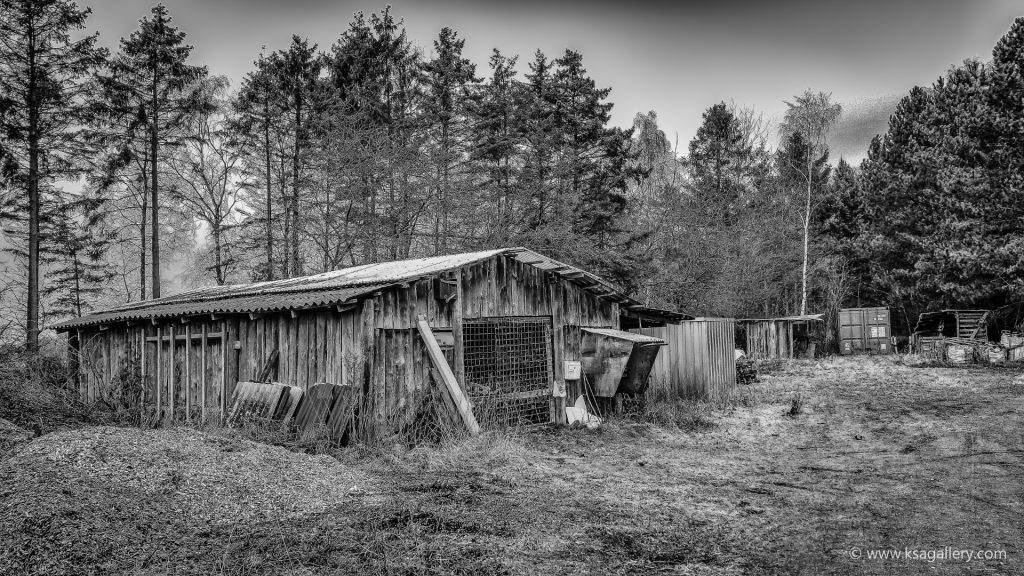
Sensing that all the grayness might be negotiable after all, it wasn't long until I came upon my next suitable motif. A flat, depressing, gray, dreary, and did I mention, gray, field of grayish brown soil, broken only by a string of bare, cold, industrial power poles. This is as gray and boring as it gets, so I figured I'd capture it if only to show you what you're up against in this country. However, while this is by no means a masterpiece, I felt that the spot actually had some potential, so I plan to return in the spring and see if I can capture a nice sunset here.
For the next image I once again had to rely on black and white to make it interesting. This may be my favorite shot of the day, but only after I took it through my Silver Effects Pro plugin.
The colors return for the next one, as the flock of geese taking off from a field makes up for an otherwise depressing scene of gray Danish flatness. I was lucky too, as a lone car passing by stirred up the birds enough for me to capture this pretty scene. A few pictures taken moments before this one, just showed the birds standing around doing nothing.
Finally, an attempt at mimicking Flickr star Nick Brundle whose favorite subject seems to be rolled up hay bales. I'm not quite at his level yet, but I was rather pleased with this one and its simplicity.
Well, while January and February will never be my favorite shooting months, I guess I got a little bit of confidence in myself today that you can in fact get something worthwhile out of the gray, light-deprived mush that we call winter around here. If nothing else, I got some much-needed exercise, covering more than 15 kilometers on my trusty iron horse.
Since my last post about my more or less failed attempt at New Year's Eve fireworks shooting, I've been wanting to put something a bit more flattering at the top of this blog. And what better excuse can you ask for than to show a few of my faves from my trip across the pond back in September? My three weeks in Idaho and Alberta (Canada) was a great opportunity for me to practice my photo skills on some of the world's most spectacular landscapes, sometimes with the inclusion of marvelous wildlife, majestic trains, and magical waterfalls.
These pictures, I hope, speak for themselves. Some of them I consider among my best work... as in, ever. Anything else would in fact have been a disappointment as even a chimpanzee with a disposable Kodak camera would have gotten several nice shots out of those locations.
Want more? Don't miss my slideshow video made from some of these and other 2016 vacation pictures.